Unifor Local 199
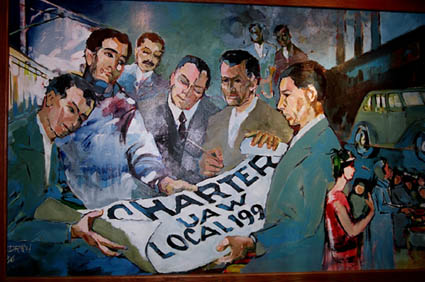
Local 199 has a long and colourful history in this community. Our local Union was formed back in 1936 when workers at McKinnon Industries signed a charter to join the UAW. At this time Local 199 became the second UAW Local in Canada. However the workers that first organized Local 199 have a history at McKinnon’s that dates back to the early 1900’s.
Over the decades collectively we have improved the working conditions in the workplace and compensation negotiated seniority rights, wages, pensions, health benefits, and new investment. These bargaining gains were not just handed over to us. Our members had to fight hard and struggle for everything. Strikes in the early days were long, often lasting many months. Our contract improvements have not only benefited the workers that Local 199 represents, but the Niagara community has grown and developed because of our struggles. Just look around the community where we spend our wages. Local businesses, dentists, doctors, lawyers and many others have profited greatly because of our wages and benefits.
Over the decades, Local 199 members haves helped raise over 29 million dollars for the United Way Campaign, helped build Brock University, a community swimming pool, the Pelham Road Clinic, built the CAW Retirement village for our retirees, donated equipment to local hospitals, have held countless plant gate collections for people in need and host a community Christmas Dinner, until the banquet hall was sold. This is just the tip of the iceberg. In the name of community spirit and fellowship, our members donate their time to volunteer, whether it is canvassing for the Diabetes or Cancer Society, coaching or even volunteering to drive cancer patients to treatment or deliver meals on wheels. We are a very important part of our community, and we should be proud of it.
This website provides a sample of photographs we have in our archives. If you recognize anyone in the photographs, would like to share information, or tell a story about our past, please contact us. If you have old photographs or a newsletter or items that are of historical interest, we would love to look at them. Anything received will be returned to you.
Jerry Dias 2014
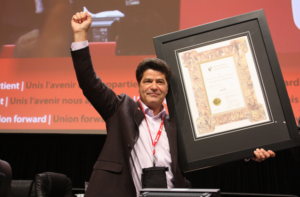 SunNews called him one of the most fearsome people in the country. In 2013, Maclean’s named him one of the most powerful. The women at the Halton Women’s Shelter with whom we works closely, call him a great ally. They are all referring to the first National President of Unifor Jerry Dias who leads Unifor’s ambitious efforts to help change the country into one in which we can all benefit from good jobs, safe communities and a prosperous, inclusive economy. Jerry has been active in the labour movement for nearly four decades, began his work life in 1978 at then de Havilland Aircraft (now Bombardier Aerospace) where he served a steward, plant chair and eventually President of Local 112. In 1993, he was appointed to the union’s national staff as the aerospace sector coordinator.
SunNews called him one of the most fearsome people in the country. In 2013, Maclean’s named him one of the most powerful. The women at the Halton Women’s Shelter with whom we works closely, call him a great ally. They are all referring to the first National President of Unifor Jerry Dias who leads Unifor’s ambitious efforts to help change the country into one in which we can all benefit from good jobs, safe communities and a prosperous, inclusive economy. Jerry has been active in the labour movement for nearly four decades, began his work life in 1978 at then de Havilland Aircraft (now Bombardier Aerospace) where he served a steward, plant chair and eventually President of Local 112. In 1993, he was appointed to the union’s national staff as the aerospace sector coordinator.
In 2007, he was appointed an assistant to the CAW National President. Jerry is an effective negotiator, who has taken on corporate giants from General Motors to Boeing to Coca-Cola. He has also led numerous campaigns including many that have prevented workplace closures and others that have led to the implementation of important improvements for workers’ safety and rights.
Charter Signed 1936
- Presidents of Unifor Local 199
- Memories of a United Auto Worker
- Women in the Union
- History of Labour Day
- 75 Years of Collective Bargaining
- Building Brock University
- 75 years in the community
- Women’s Auxiliary #50
- Jack Layton NDP
- Bert Hillier
- James Connell
- Gerry Michaud
- John Clout
- Pudge Dawson
- Gordon L. Lambert
- Eric Cooper
- Len Harrison (1934 – 2018)
- Ron Davis
Presidents of Unifor Local 199
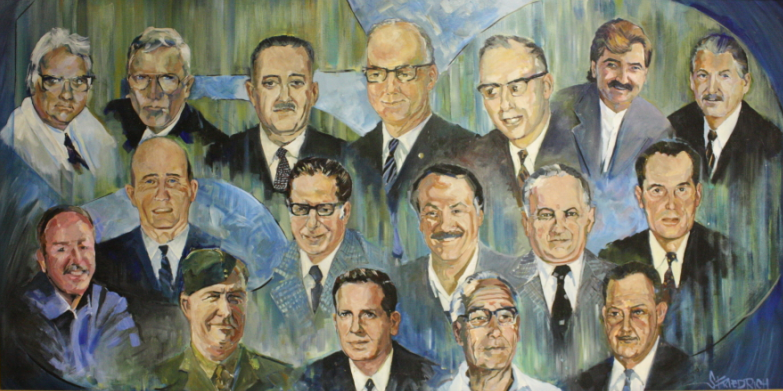
Since the Charter was signed in 1936 the membership of Local 199 has had 18 different presidents. The length off office has ranged from one to twelve years, Jim Connell served the longest (1964-1976). Wayne Gates would have served as president for 13 years however in 2014 Wayne retired from office two years early when he was elected as an MPP in Niagara Falls.
Memories of A United Auto Worker
Memories of a United Auto Worker By Jean McKenna (Pritchett) McKinnon Industries/GM St. Catharines
Some photographs have been substituted.

I worked in the Delco plant of McKinnon Industries GM for a number of years, shortly after leaving school in the depth of the depression. As I recall, we had school teachers, office workers and other educated people in the plant, simply because there were no other jobs available.When I was hired, I recall standing in line at the gates morning after morning, hoping to be selected for a job. After making application, it was up to a man in charge of hiring to select a few people at random for the jobs available that day. I was finally selected and started to work in the department producing motors for refrigerators – stator winding. It was a piece work job with a base rate of 25 cents per hour but of course, one must produce more than that to remain on the job.Never having worked at manual labour the going was tough. My fingers soon peeled like banana skins and the pain never stopped. In addition, the constant pressure on my index fingers caused them to bend out of shape and they remain so to this day.I soon found that being called for a job only meant that work was available for a short time. A rush order had been received and it might take a few days or a few months to fill it. If it was a longer job we would be called upon to work 12 hours per day and six and one half days a week; allowing half a day for Sunday. Many times I recall sitting at the dinner table and falling asleep before I could eat a bite.As the ruse was over, we would stand by for a call to return to work, sometimes for half a day and sometimes longer. It depended upon the forelady of the department for how long. If you were a friend it meant a few more days and it had nothing to do with seniority.In 1936 we heard rumours about a union being formed in Oshawa and I was contacted by a couple of boys from the foundry who were interested. I wasn’t opposed but neither was I willing to do very much at that time. My contacts were Charlie Williamson and I also met Dick Steele a Young Communist League leader who later died as an early casualty of the Second World War.In 1937, after a strike at the Oshawa plant, an open meeting was called in St. Catharines and addressed by Charlie Millard. The hall on Queen St. was packed and Charlie Millard was a good speaker, so the ground was laid for a drive for union membership. Oshawa needed our support because we were a parts plant for their assembly line.The following Saturday, after talking it over with my friend and co-worker, we proceeded to the union hall and I paid my initiation and union dues and much to my surprise, my friend refused to join. She refused to explain her reasons and on subsequent occasions when I asked her about it she became more and more hostile. I was the only woman in the department of approximately 12 women who joined. Subsequently two other women joined, one from my department.During this organizational period, the superintendent, a man by the name of Tom Cook, called several plant meetings of women only and explained why they didn’t need a union, stating that he knew the names of the women already signed up. This amused me since I was the only member.Shortly after the organizational drive, an executive was elected and I became the first recording secretary of Local 199. Jack Crozier became the president, Jack Campbell the treasurer, Bert Hillier and I believe Charlie Williamson. There may have been others but my memory fails me with their names. Robert Lewis was hired as business manager We proceeded then with the help of a lawyer from Toronto, Jake Cohen, to set up a meeting with the company to negotiate a contract with emphasis on recognition of the union. It was tough going and the management in that plant were adamant in their refusal to grant recognition or in fact any demands.

As a result of a settlement in Oshawa we were advised to accept the slim offerings and recommended acceptance to the membership. I wasn’t very happy about it but at a membership meeting in the high school auditorium with 1,200 people attending, the vote was to accept. I did’t learn until later that our bargaining position was poor because we had a bare 50% of the employees signed up. We were able to pick up a number of stragglers after the meeting. Our troubles weren’t over. The management did everything they could to subvert the bare bones agreement. I remember in our department a petition was circulated asking that we be dropped from the union because we were not autoworkers. As shop steward I turned the petition over to our plant committee and as a result was promptly laid off for a week. The union paid my wages rather than fight it.
Later another girl who had joined the union under my urging, was laid off and since I felt personally responsible, I continuously raised it to the union. It was taken up with top management and their position was that under the agreement signed they had a right to lay off anyone under the six month clause that we had signed. The union executive seemed prepared to accept this but I wasn’t. Our committee raised the question with top management and it was agreed that the girl would be returned to work.

Even after Carmichael, the general manager of GM agreed to this, the plant management refused. The case was taken to conciliation, we won again and plant management refused to hire the girl. Our grievance committee raised it and finally I was told to take it up with “Wecker” plant manager and give him an ultimatum. He turned shades of red and blue while I stood my ground. I had visions of being thrown out of the office bodily. A year later the girl was re-hired but with no remuneration for loss of pay. I don’t think she ever believed that the union actually returned her to work.It was obvious that management was using the weakest links to break the union. Since we were a piece work department, it was a simple matter to re-time jobs thus cutting wages and while the hourly rate had been increased, it created speed-up to stay above the base rate on the new cute rates. I never could explain this to the satisfaction of the executive and negotiating committee.
After the sit-down strikes in flint, Michigan, union fever was running high and schools were set up in Michigan to explain union, agreements, grievance procedure, etc. I attended one of these schools in Michigan. It was quite an experience and I found firm political lines drawn. I gravitated towards the left and later fell out of favor with many of my executive.

On my return, after accepting a ride with Chas Millard, our Regional Director, we were involved in an accident and I was laid up for several weeks. Another man was appointed to act as recording secretary and Fred Steeve finally won the election to that post.Since women were a rather scarce commodity in the early days of our union, I found that I was tolerated except when I tried to make a point on the union floor and would be told “Miss Blair doesn’t know what she is talking about.” In retrospect and acquired knowledge perhaps I didn’t but it wasn’t much encouragement to remain as an active member.
In 1939 rumbles of war was the order of the day. I took the position that Chamberlain had assured a war in the pact that he signed with Hitler. My fellow employees disagreed in view of the patriotic fervor being aroused in the plant. GM made it a practice to draw a $5 award in accident free departments and the first draw after patriotism took over was a war bond – I won it!
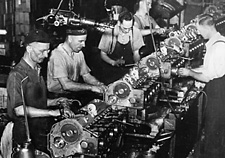
Link to More Images of Len Harrison
At this time, after nine years in GM, I decided that I should try for other work. I took a job in a coffee shop and shortly after GM went on strike. I supported the strike and finally quit the job to do my stint on the picket line. It was a tough struggle with all forces against the strikers on the basis of patriotism. RCMP were called out and they mounted machine guns at both ends of the picket line on Ontario St. Many of the officers were young men and union girls were soon dating them. It made me sick – those guns were loaded and only needed a command to gun us down if an incident had occurred on the picket line.After the strike I was able to find office work and was able to polish up on learned skills. I may have expected too much but when I asked for a wage increase, I found that I had to lay the job on the line in order to press the point. I changed jobs frequently and finally decided to leave Ontario. I believe my union activity followed me into the offices in spite of the war and shortage of staff, management was not ready for union talk in the office.
Women In the Union
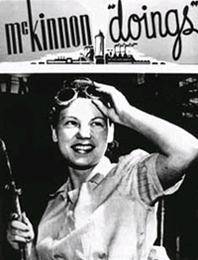
Within the trade union movement itself, the war brought to the fore a contradiction that, while not new, could no longer be ignored. The CIO and industrial unionism had crusaded for the equality of all workers, and working women, especially in the clothing industry, joined unions in large numbers. But wages in the sectors that employed women were low while in the new sectors such as auto, companies rarely hired women. Even when women got jobs in auto, their wages were about two-thirds of men’s (or lower), and management restricted women to separate seniority lists.At GM, in the thirties, the Oshawa and St. Catharines plants each employed over 200 women. In addition, women reps sat on the bargaining committee, but they generally represented women who worked in segregated departments such as the sewing room. The original GM agreement of 1937 included a clause reading: “In any department in which both men and women are employed they should be divided into separate non-interchangeable occupational groups”.
Soon after that agreement, when the economy slowed down and lay-offs returned, the union argued that positions should be found in other departments for those women with highest seniority. Although some inequities were later corrected, GM’s Oshawa plant manager replied, at a meeting on 24 September 1937, that GM would unilaterally decide how many women to hire, adding that “the management did not favour mixing male and female ‘help’ in a department”.
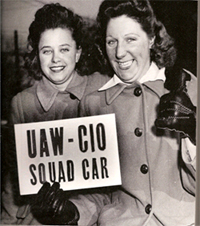
As young men left for the battlefield and the economy geared itself to the overseas war needs, Canada moved from unemployment to a situation where, by 1942, companies were competing for workers. For many companies and the government, women were the answer. Rather than attracting scarce workers with higher wages or better conditions, the companies could bring a new pool of labour into the factories and segregate these women workers in certain departments. Confident that the position offered to women – temporary, new to the labour market, separated from experienced union activists – would limit the development of their trade union consciousness and make them easier to control, the companies paid them lower wages.In Oshawa, the number of women workers doubled (to 400); in St. Catharines, over one-quarter of the workforce was now women (1,200 of 4,500); at de Havilland, women (1,775) represented over half the workforce. In the auto industry before the war, only one worker in fourteen was female; this number more than doubled by 1943. In aerospace, the number of women was previously negligible; it rose to better than one in five workers (though they were still concentrated in certain lines of work). In agricultural implements, the proportion of women quadrupled from about five per cent to almost twenty per cent.
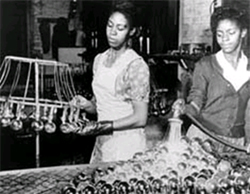
With popular culture supporting the inclusion of women in the workforce and with women participating in production, many thought that prevailing stereotypes of the role of women might change. After all, magazines now glorified the woman who left her home to produce for the war, popular songs such as “Rosie-the-Riveter” paid tribute to her, governments and companies not only endorsed but actually provided child-care services, and women showed that they were capable of heavy manufacturing and skilled work.In spite of the apparent social support for women entering the workforce, their status remained inferior. The gendered division that the auto majors enforced was effective. If women had, for example, worked on the assembly line, doing the same work as men, the pressures from both the women and their fellow male unionists might have led to wage parity. But the company managed to avoid this outcome.
In motor vehicle assembly, employment increased by about 8,400 workers between 1939 and the wartime peak of 1942-43; but only 130 of these new workers, less than two per cent, were women. Even though the number of workers in the assembly sector increased by two-thirds between 1929 and 1949, the number of women – low as it was to start with – actually fell. Women were hired in certain sections of the parts sector, in traditional women’s departments within the auto majors, or temporary divisions expected to disappear after the war. General Motors, for example, created a special Victory Shift for women which was to end when victory was achieved.

Some definite changes in attitude occurred. The Detroit office of the UAW established a Women’s Bureau. With no automatic dues check-off, the union collected dues on an individual voluntary basis; this increased pressures to set out demands that would gain the support of women. Amalgamated locals such as Local 195 in Windsor and Local 397 in Brantford, which represented women in auto parts and miscellaneous manufacturing, successfully negotiated equal pay for equal work. Within the Big Three, Local 199 in St. Catharines was one of a number of locals who regularly raised the issue at the council, warning in June, 1942, that “unless the union=able to give leadership to the struggle for equal pay for equal work we will remain weak among the women”.The first strike of Ford Canada workers centred around the concern that Ford would replace men with lower-paid women. The union’s demand was not to oppose the hiring of women, but to insist that they earn the same wages. Ford Canada’s eventual response was that hiring women was worthwhile only if they were cheaper, and it refused to hire women at its assembly plants until 1977. Although the union leadership did raise the issue of equal pay with the broader public, the union did not launch a campaign to challenge Ford when it stopped hiring women in Canada. In the U.S., on the other hand, Ford was a major employer of women. This discrepancy may have stemmed from the differing structures of the company in the U.S. and in Canada. Whereas the Canadian operations were heavily weighted to assembly, the U.S. operations included an extensive parts manufacturing sector that could absorb lower-paid women workers.

After the war, many of these women, especially those who were married, were quite effectively returned to the kitchen. This trend was a matter of both company and government policy, reflected not only in lay-off policy but also in the closing of the extensive child-care centres that had been set up during the war. Yet women’s return to the home also had a wide base of support amongst male and even female workers. There were isolated examples of resistance on the part of women, but as Pam Sugiman commented in Labour’s Dilemma, her study of women in the Canadian UAW, the more common occurrence in the immediate postwar period was that “Married women disappeared as quietly and unassumingly as they had appeared in the auto plants.”Women’s exposure to the world of work during the war did, however, have some lasting impact. In the decades after the war, the proportion of women in the workforce resumed a steady climb. Many of the married women who had entered the workforce in the war years and then returned to the home went back to work after their children grew up, influenced in part by their wartime experience. Furthermore, later studies indicated that women with wartime work experience passed on to their daughters attitudes that were more sympathetic to women’s role in the workforce.

The story of women in the workforce during and after the war years contrasts in significant ways with the experience of black workers in the United States. The labour shortage and the relatively high wages in Detroit had attracted southern whites and blacks to Detroit. Racism against blacks was intense in spite of efforts by the UAW leadership to limit it: 100,000 person-days of wildcats occurred when whites (often but not always from the South) refused to work alongside blacks. The racism culminated in the horror of the Detroit race riots in the summer of 1943, when thirty-four people were killed. Yet, after the war, blacks, unlike women, remained a significant part of the auto workforce.The difference, it seems, was that the role of blacks as paid workers wasn’t generally challenged; the fight was over some white workers insisting that blacks be segregated. With women, on the other hand, it was their role as permanent paid workers that was not yet accepted. The truth was that the equality of women in the workplace could not be achieved unless the union addressed the broader role of women in the family and in society. As long as it was generally assumed that the role of women was primarily in the home, their role in the war would be viewed as temporary regardless of the rhetoric. Men might join in the fight for equal pay because they recognized this fight as being in their own self-interest; women accepting lower pay would be a competitive threat to their own jobs. But not so with seniority. Fewer workers with full seniority rights means more security for those with full rights (at least in the short run when solidarity an issue).
Indicative of these assumptions about the place of women in society was the role of the women’s auxiliaries, organizations of wives of autoworkers established to assist the men in their struggles. The auxiliary in Oshawa, which became the largest such group in either Canada or the United States, was established before the 1937 strike began. These auxiliaries quickly spread throughout the union. They supplied coffee and sandwiches during strikes and sometimes joined the picket lines. They evolved into a social club for the participating women, who organized recreational and charity work.
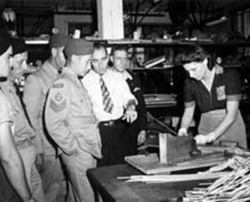
But these women also saw themselves in broader political terms. In many locations – Oshawa one example – they supplemented the work of the union by mobilizing within the community and sometimes nationally for better housing, rent controls, and national medicare. They supported key labour struggles outside the UAW, participated in the peace movement in the sixties, and addressed international issues.Yet the auxiliaries and the working women in the UAW seemed to inhabit completely different worlds. Few links were established. As the participation of women in the workforce later grew, and as a feminist consciousness developed in the seventies and eighties, the membership of the auxiliaries correspondingly declined, especially amongst younger women.
When the war ended and lay-offs replaced labour shortages, the prevailing assumption that women’s real role was in the home directly led to separate seniority lists. Even the fight for equal pay, as long as it was about equality in the abstract, rather than the pay of workers who were truly equal, would not attract the kind of commitment and mobilization needed to change the existing pay structures. Working women had not yet developed their own self-confidence and were not yet in a position to build on the experiences of the war to transform society’s (and their own) view of women’s role. They had little or no supportive resources inside or outside the union. The Women’s Bureau, for example, was in Detroit and itself had limited resources. Changes occurred, but they came slowly and not before the notion of a broader women’s movement was on the agenda.
The History Of Labour Day
Over one hundred years ago, in 1894, the Canadian government proclaimed the first Monday in September as Labour Day, a statutory holiday. The fact that this holiday was only the second declared in Canada, speaks volumes about the working conditions at the time. In the early 1800’s, a normal work week in Canada and the U.S. was 14 to 16 hours a day, 7 days a week. As you can imagine, workers were not happy with these working conditions, and were forced to go on strike to reduce their working hours.
Canadian workers went on strike in 1834 for a 10 hour day, and again in 1872 for a 9 hour day. By the late 1800’s, workers began to organize and challenge employers to further reduce working hours to 8 hours per day. Thousands of workers and their families took to the streets. They marched peacefully to local parks, enjoyed picnics and talked about worker’s issues. Leaders promoted the concept that if workers were prepared to challenge those in power, the rewards would be dignity and respect in the workplace and shorter working hours. In the 1880’s, workers voices united across Canada and the U.S. Their common demand supported by all was simple, an 8-hour work day. 130,000 workers had successfully negotiated a shorter work day by April of 1886. In May of the same year, 3,500 strikes were taking place throughout the U.S. and Canada.
Workers Died Demanding Rights
Obviously factory owners, bankers and merchants were all strongly opposed to any such concept; shorter hours would impact their profits. They reacted by lobbying the government, who opposed the growing militancy with vicious police attacks and arrests of activists.
On May 1st 1886, at a peaceful rally in Milwaukee, blood started to spill. Police opened fire on protesting workers. Tragically, nine workers were killed. On May 3rd 1886, the Chicago police killed six more demonstrators. One day later, on May the 4th, the bloodshed continued. 5,000 demonstrators stood in a light rain at Haymarket Square in Chicago to listen to August Spies talk about workers rights and the need for an 8-hour day. The crowd was so calm that the Mayor of Chicago, who had stopped by to watch, walked home early. As the rain intensified, the crowds started to leave. With only 400 demonstrators left, the police marched forward in formation. As they surrounded the workers, “all hell broke loose”. A bomb exploded and shots were fired. At the end of the confrontation 8 were killed; of which 6 were police officers. Countless protesters were injured and did not seek medical attention for fear of repercussions. It was noted that most of the injuries were from bullets and only the police had guns
In the aftermath of the protest, eight U.S. labour leaders were charged, tried and found guilty. Seven were sentenced to hang and one received a life sentence. Protests and demonstrations followed. World leaders asked for leniency, but the government and businesses wanted their pound of flesh. The workers had demanded too much and had to be put in their proper place – death was the only answer.
The 8 Hour Day Was Born
Demonstrations continued on May 1st in the following years. In July 1889 the International Labour Congress met in Paris. Labour groups from around the world came to discuss workers issues. At this conference they voted to declare May 1st an International Day of Demonstration in support of the 8-hour day. The pressure continued by trade unionists, and in 1894, both Canada and the U.S. governments passed similar laws. However, they declared the first Monday in September as Labour Day rather than May 1st. This was to draw attention away from the bloody events that occurred in May and what it symbolized to workers.
It is our responsibility not to forget those workers and the history of Labour Day. It is important that we retell this tragic story and remind ourselves that workers died in the streets so that we can enjoy an eight hour work day
Collective Bargaining
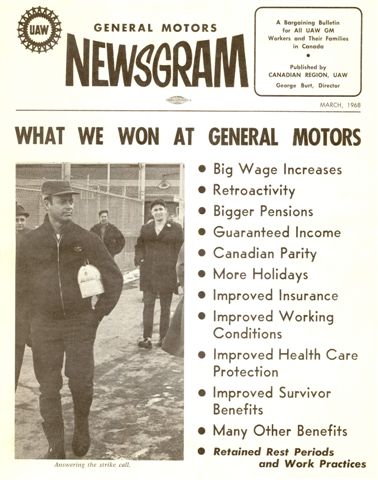
75 Years of Bargaining
Have you ever heard the expression Rome wasn’t built in a day? Well, the same analogy can be used for the collective bargaining process. It takes time and commitment to negotiate a good collective agreement. The blocks to build a good contract start with organizing and joining a union. Once workers have a union to represent them, a contract can be negotiated. With each subsequent round of negotiations improvements can be made and new language can be added. As an example of what can be achieved, the following is a chronological list of the bargaining gains made by our GM members.
– 1937, Local 199 Signs UAW Charter
– 1937, First Contract Negotiated at McKinnon’s
– 1937, Collective Agreement – First Contract at GM
– 1940, Paid Vacation
– 1941, McKinnon’s Wage Parity with GM
– 1943, Union Recognition
– 1945, Post War Wage Increases
– 1945, Union Security (Rand Formula)
– 1948, Paid Holidays
– 1948, Cost of Living Allowance, (COLA)
– 1950, Employer Paid Pensions
– 1950, Annual Improvement Factor (Wage AIF)
– 1953, Local Agreements in effect
– 1954, Medical/hospital/ surgical coverage
– 1955, Supplemental Unemployment Benefits (SUB)
– 1964, Paid Time Off
– 1964, Overtime Rules
– 1964, Paid Jury Duty
– 1964, Signing Bonus
– 1970, Early Retirement Option (55 + 30 = Out)
– 1973, Vision & Dental Benefits
– 1973, Health & Safety Committees
– 1973, Voluntary Overtime
– 1976, Paid Personal Holidays (PPH)
– 1976, Shorter work week
– 1976, 30 & Out Pension, (regardless of age)
– 1976, Hearing Aids
– 1977, Paid Education Leave (PEL)
– 1982, Paid Maternity Leave
– 1982, Pension Coverage for Laid off Workers
– 1983, Child Care
– 1984, Legal Services Plan
– 1984, Income Maintenance Plan (IMP)
– 1984, Union Counsellors
– 1984, Affirmative Action
– 1986, Health & Safety Company Wide Coordinators
– 1986, Weekend Workers
– 1987, Pension Indexing (for future retirees)
– 1987, Child care Expanded
– 1987, Letter of Neutrality, No interference to Organize
– 1990, Social Justice Fund
– 1990, Four Day Weekends
– 1990, Vacation Bonus
– 1990, Income Security Program
– 1990, Improved Severance package
– 1992, Same Sex Benefits
– 1993, Scheduled Paid Absence (SPA Weeks)
– 1993, Lump Sum Retirement Incentives
– 1993, Employment Equity Representatives / Women’s Advocates
– 1993, Harassment Training: Right to Refuse
– 1996, IMP /SUB closure Language
– 1996, Outsource Protection / Work Ownership
– 1996, Protection from Changes to Labour Laws
– 1996, Union Training Funds (WTP)
– 1999, Pension Indexation (for all past and future retirees)
– 1999, New Childcare Benefit
– 1999, Tuition Assistance for Dependents
– 2002, Investment and Job for Canadian Facilities
– 2002, Laser Eye Surgery
– 2002, Paramedical Services
– 2002, Dependents of Retirees now covered for tuition refund
– 2005, Pension for Surviving Children
– 2005, Car Discounts
– 2005, Car Insurance Rebate
– 2005, PSA Test
– 2005, Eye Examination Coverage
– 2005, GM Bargaining Highlights
– 2009, Government Loans
– 2016, TBA
This is a comprehensive list of Collective Bargaining firsts, but not all gains are included.
Brock University
Brock unveils plaque honouring early union supporters in Niagara
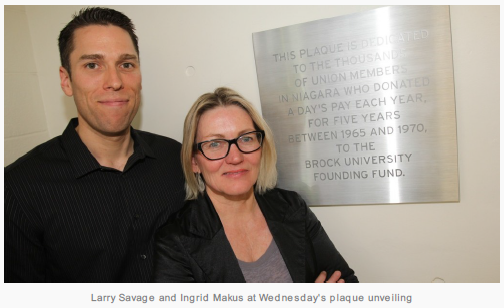
Brock unveiled a new plaque recognizing the significant contributions that local union members made to the University’s Founding Fund from 1965 to 1970. The plaque, which is located on the 300-level of Mackenzie Chown where blocks B and C meet, was proposed by Brock’s Centre for Labour Studies as part of the University’s 50th anniversary celebrations.
“This plaque commemorates the contributions of unions and the labour movement to the very foundation of Brock University,” said Ingrid Makus, acting dean, Faculty of Social Sciences, at yesterday’s event. “This group of supporters was one of the first to provide voluntary financial contributions to the founding of the University.”
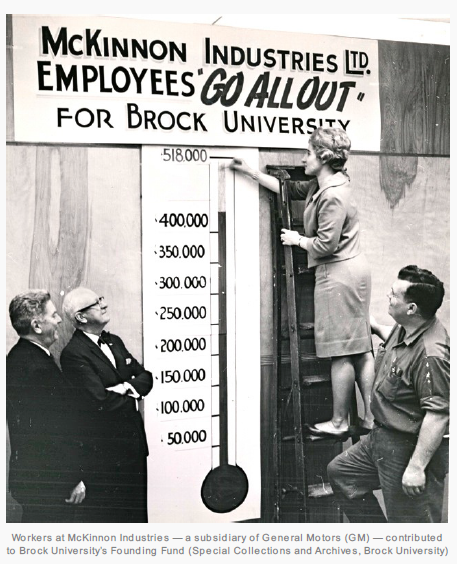
McKinnon Workers “Go all Out”
Labour unions played a key role in organizing voluntary payroll deduction in work sites across Niagara in support of the early growth and development of the University. “On Jan. 22, 1965, more than 100 union leaders and activists from the region were invited to a dinner hosted by the University’s Founders Committee,” said Larry Savage, director, Centre for Labour Studies at Brock. “At that meeting they voted unanimously to encourage their members to donate a day’s pay per year for the next five years to contribute to the founding fund of the University.” Organized labour in Niagara set itself a goal of $1-million, but, by 1970, had surpassed this target, having raised more than $1.4 million for the Founding Fund. This amount represented almost a quarter of the total amount raised by the Founders Committee. “Imagine that,” said Savage. “And those are 1970s dollars, so that’s a much bigger donation by today’s standards.”
This year also marks a significant anniversary for Brock’s Centre for Labour Studies, which is celebrating its 25 anniversary. “Labour Studies takes seriously what Brock is known for now, interdisciplinary research and teaching, and community engagement among faculty, students and staff,” said Makus. Workers at McKinnon Industries – a subsidiary of General Mo tors (G M) – contributed to Brock University’s Founding Fund (Special Collections and Archives, Brock University)
The new plaque reads: “This plaque is dedicated to the thousands of union members in Niagara who donated a day’s pay each year, for the five years between 1965 and 1970, to the Brock University Founding Fund” “The plaque is very important because most students don’t know about this history, and surprisingly most faculty and staff don’t know about this history,” said Savage. “Those past generations of working men and women did not make this contribution for themselves. They did it for their children and grandchildren because they understood what it meant to build community and build education for future generations.”
Building Brock University
by Nathan Bell & Peter Scott
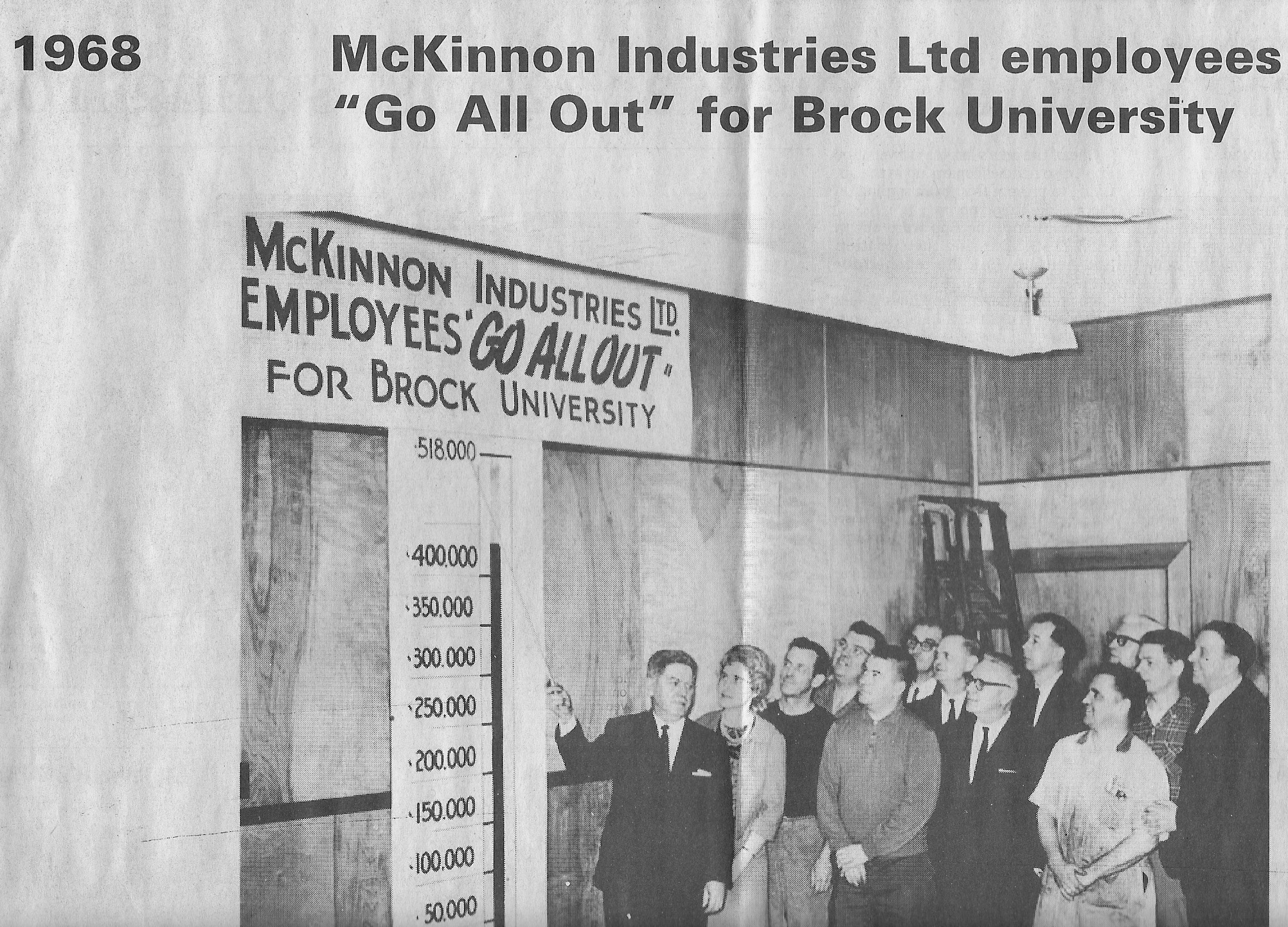
The labour movement has always played an important role in the Niagara region, yet its role may never have been as important as it was in the early 1960’s. At that time, there were extensive discussions regarding opening a new university in the area. The United Auto Workers Union (now Unifor) decided to raise money to further the cause. By the end of 1963, members of the local union had raised and donated over $500,000 to Brock University which was currently under construction in St. Catharines.
We had the good fortune of speaking with Welland’s Member of Parliament, Malcolm Allen about the role labour played in the building of Brock University.
As a youngster, Malcolm moved with his family from Glasgow, Scotland and settled in the Niagara region. His father worked at McKinnon’s Industries to support the family and dreamed of giving his children an opportunity to a post secondary education. When discussions about a local university began, Malcolm’s father and other UAW workers jumped at the opportunity to raise funds for the school.
“At that time it was unheard of for the son of a factory worker to attend university or college. University students were children of lawyers or doctors. We didn’t have that opportunity until Brock University opened up. This university allowed us to have a chance at a different life, something we never dreamed of before.’
Malcolm’s appreciation of the Auto Workers Union is sincere.
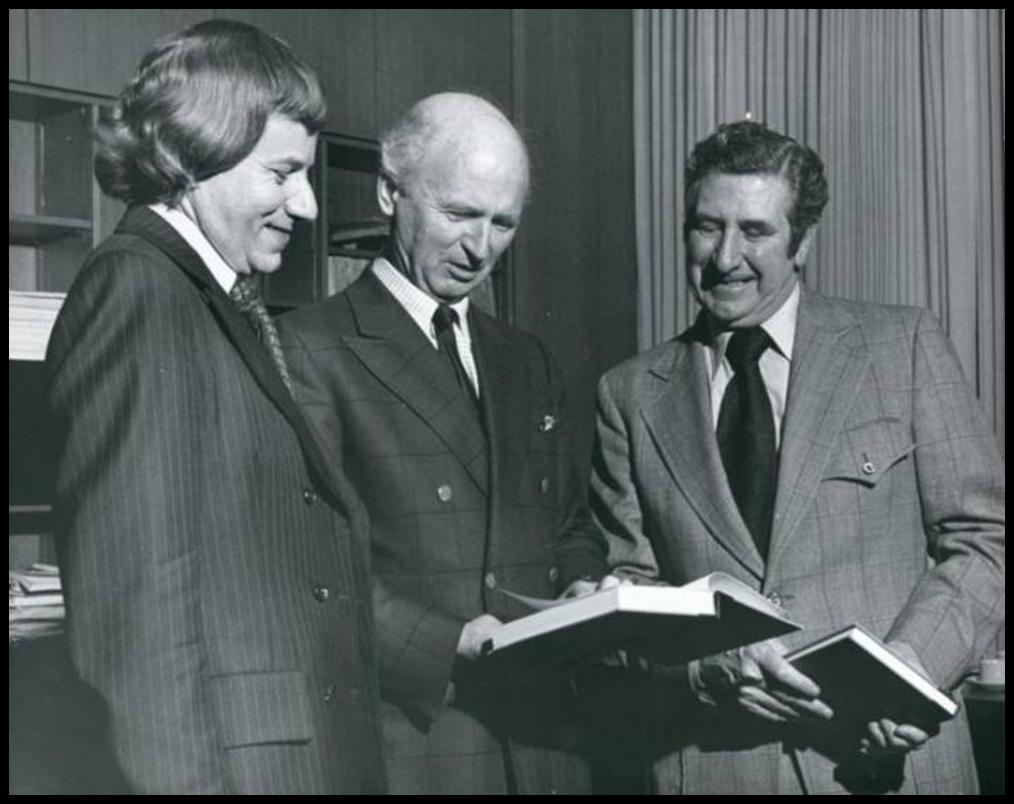
“Without the enormous contribution from the workers and the union as a whole, there is little to no chance that a child coming from a working class family would have had the chance to experience this opportunity. What the workers managed to donate to the university and its students was an unprecedented amount of money at that time”
A payroll deduction for each worker who signed up was made. The amount on average was 4 percent of the workers wage, approximately one days wages per year, a pricely sum in any decade. This paved the way for thousands like Malcolm to pursue their dreams.
The donation which came from McKinnons workers gave the Brock Founding Fund it’s biggest boost, the $518,000 donated was the largest single donation by employees of a single employer to any university in Canada!
“It was quite remarkable to see the power of the labour movement come together, and every Brock student, past and present, should be grateful for the contribution made by the UAW workers. Sadly, to this day there is nothing in Brock acknowledging the UAW workers’ generous contributions to the initial building of the university. The majority of students are completely unaware that the UAW even contributed at all.”
Local 199 also helped students in other ways; to help prevent students from falling into tremendous debt they negotiated a Tuition Assistance program. Malcolm explained that although he originally had to pay for his tuition and would be reimbursed if he passed. To this day, both Unifor and Local 199 have a number of different bursaries for students. (For more information about these bursaries and the tuition assistance programs CAW members should contact the benefit rep or visit our website www.unifor199.org)
Malcolm expressed a general disappointment with the near non-existence of labour education in Canadian elementary and high schools.
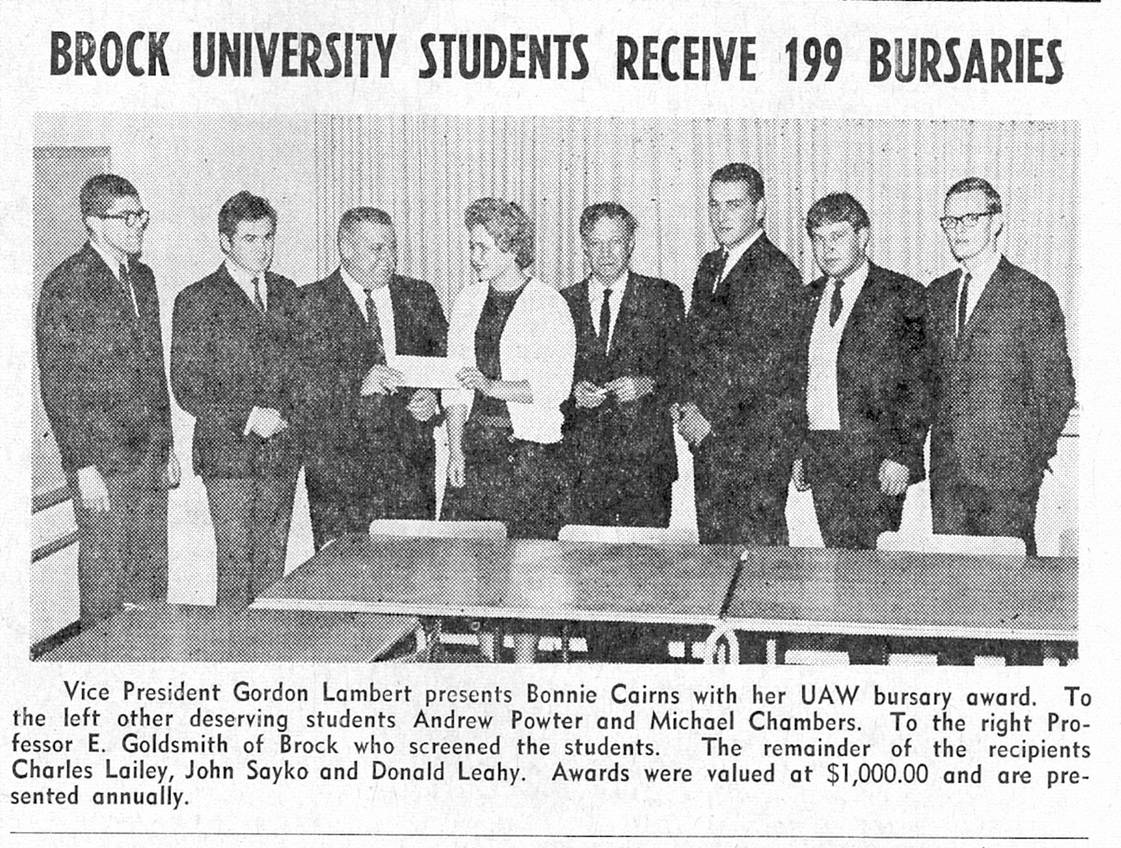
“Labour is missing from the curriculum. From a high school context, the only labour education a student receives is generally about the Winnipeg strike, which is taught in history class. Unless the students are fortunate enough to have a teacher interested in labour, they are completely unaware of the many issues regarding the labour movement.”
The Autoworkers generous donations paved the way for the opening of the Brock university and their efforts gave thousands of local students the chance to achieve a post secondary education their parents only dreamed of.
Malcolm Allen credits his success to having the opportunity to access a university education. He was the first person in his family to obtain a university degree, a degree that helped him become the first member of Local 199 to become a Member of Parliament.

75 years in the community
We Walk Across Bridges Built by Those Who Passed Before Us

Eighty years ago, in 1936, workers at McKinnon’s Industries made a bold and brave statement; they put the company on notice and joined a union. When these workers at McKinnon’s signed the UAW Charter they formed the second United Auto Workers Local in Canada. This year we celebrate 80 years of solidarity, the collective bargaining gains we have made, acknowledge the positive changes we have made to our community, and society as a whole.
Back in the 1930’s working in McKinnon’s was no picnic, work was hard, dirty and dangerous and the benefits were few. As a reminder for us all I have included a link to a Speech written by Pudge Dawson, who first worked in the plant and served our members back in the late thirties. It is an interesting read.
Our collective bargaining gains could not have been accomplished without the courage of our predecessors, who fought the boss at every turn, walked the picket line and stood shoulder to shoulder when times were tough. The First Contract signed in 1937 consisted of only one or two pages an a few paragraphs. Today our contract has grown to hundreds of pages, a Master and Local Agreement not to mention all the supplemental agreements. We certainly have come a long way in the past 74 years.
Today I would like to congratulate all our members and acknowledge the foresight solidarity and determination of those workers who took the first step and formed our local union.
As we enter our seventy fifth year, I would like to talk about some of the things the Executive Board are planning for our 75th anniversary. We will produce a special 75th anniversary edition of the 199 news, review and update our website, have a Logo Design Contest, spice up the 2011 Labour Day Parade and end the year with a dinner celebration with special guests and speakers. Any event the local is involved with this coming year will have a 75th anniversary flavour.
With that in mind I would like to ask for your help in making 2011 a memorable year. If you have pictures of the plant, our members past and present, our units, magazines, old news paper clipping, we would like to see them. Anything that comes in will be copied and returned, all donations will be welcomed and saved in our archives. The best will be published in the 199 news and on our website.
We also need volunteers to help with every event. Our standing committees will all be asked to take a lead role in making 2011 a year the community will remember for a long time. Please take some time to reflect on the past, celebrate our victories, acknowledge our past, and help us make this a special year.
Women’s Auxiliary #50 UAW/CAW Local 199
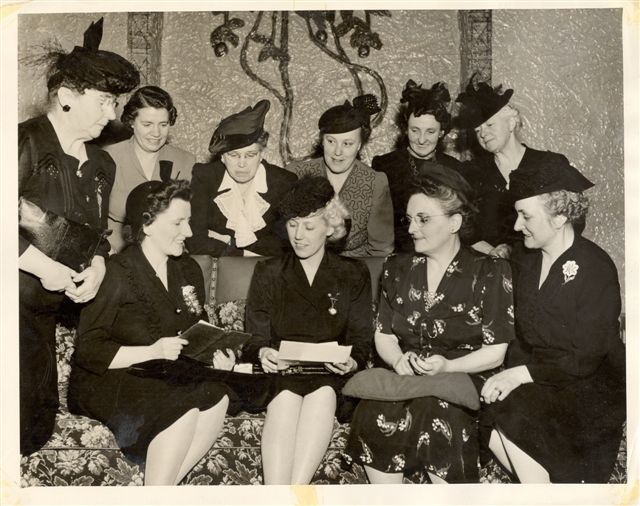
In the Beginning
Interest in creating Women’s Auxiliaries started during the UAW organizing drive in November of 1936. The first women’s auxiliary was formed in Michigan in 1937 to take part in the Flint sit-down strike in January of 1937 where they played a pivotal role in the strike action. The women’s Auxiliary and Emergency Brigade also participated in the “Battle of the Overpass” at Ford on May 27th, 1937. In subsequent strikes, the Women’s Auxiliary were active is setting up strike kitchens to feed the members, arranging benefit dances, and holding meetings to gain sympathy for the strikers. Because of the successes of these early days during the late thirties, thirty-three Women’s Auxiliaries were established, including Auxiliary # 50 in St. Catharines.
The Women’s Auxiliary # 50 of Local 199 was formed on November 1937, this was only eleven months after local 199 signed its charter on December 15th 1936. In the beginning, it was a difficult task to find twenty women that were needed to form an auxiliary, but finally the charter was signed on November 14th 1937.
Duties of the Auxiliary
Back in the thirties being involved in the Union was a real family affair. The UAW quickly realized in order for the Union to succeed, they needed not only to win over the workers, it was very important that the workers families were firmly behind them. In order for the union leadership to be effective and to do a good job representing the membership, they required help and support from their families. If workers had to go on strike to make gains for their family, the workers families needed to understand what they were fighting for. For the general public to support the workers, they too needed to be educated. The initial purpose of organizing an auxiliary was to bring together spouses, daughters, mothers and sisters of Union members. Education was a priority, they would learn what unions were all about, their principles, the issues of the day, and to offer aid and support to the membership when it was needed.
Financing the Auxiliary
To put things in perspective, when the auxiliary was first organized the decade was known as the hungry thirties, money and food was hard to come by, At the time workers were being paid approximately 25 /45 cents per hour. The Auxiliary membership dues were set at 15 cents per member, per month. The dues were approximately half an hours pay per month. As in most organizations finding funding to finance the work of the auxiliary was hard to do and hampered their progress. Sister Annie Dunlop suggested that they run a bingo game. With no money to buy prizes the suggestion was initially turned down. However, Sister Dunlop was persistent and continued to push the idea forward. The Local union offered to give the auxiliary a small loan to purchase prizes, rent a hall and the equipment needed. The first bingo game was held in 1938 in Dunn’s hall on Queenston Street and later moved to Queen Street. Eventually enough money was raised to repay the loan, purchase equipment and starting helping the community. Sister Dunlop’s imitative paid dividends for many years to come. Other funding initiatives included; bazaars bake sales, auctions, rummage sales, draws, and catering.
Home Base
Throughout the years the Women’s Auxiliary had several different offices. In 1937, the founding members rented office space above the St Catharines Standard on Queen Street, moved to the Labour Temple on Mary Street, then to the UAW offices on Carlisle Street. In 1973 the Auxiliary moved to 124 Bunting Road in St. Catharines. When the Local Union built the new union hall in 1973 and hired a staff to handle the catering duties, it was at this time the cooking and banquet duties of the Women”s Auxiliary ended .
Soup for Strikers
In 1941, the union was forced out on strike by McKinnon’s Industries the Women’s Auxiliary went to work supporting the membership. Sister Campbell took over organizing the kitchen to feed the strikers. With a shortage of funds to purchase food, the auxiliary had to rely on donations from local farmers, merchants and restaurants. The Auxiliary worked in the kitchen from 6 am to 12 pm everyday. Hot soup was always available for the picketers. With only twenty auxiliary members as you can imagine feeding several thousand men was no small task.
After the strike was over the ranks of the Auxiliary grew, younger members joined and subsequently were put to work. In 1948 McKinnon”s workers once again went on strike the auxiliary expanded the menu, making tea, coffee, soup and sandwiches to feed the picketers. Volunteers which incidentally included men who were unable to physically walk the picket line assisted them whenever necessary.
In 1955, the auxiliary’s task was made more difficult by the fact that the contract expired in September and any lengthy dispute would run into the winter months. This strike lasted through Christmas and the coldest part of the winter. The women’s auxiliary had to not only feed the strikers, they wanted to ensure the children had a happy Christmas. The auxiliary went to work making hundreds of dolls and clothes. By the end of December giant bags of toys were distributed to over one thousand families. Without the Women’s Auxiliary Christmas morning in 1955 would have been a very bleak and solemn affair.
The 1948 strike lasted 150 days, the 1955 strike last 148 days. Without the support of the Auxiliary it would have been unlikely that the strikers would have endured as well as they did. This support enabled the workers to remain steadfast and make the gains that they did. 1955 Strike CBC News
Supporting those in need
Over the years, the Women’s Auxiliary role continued to expand. They championed many causes and supported a long list of community organizations. Women’s Auxiliary #50 would cook for retiree’s parties, members’ weddings, stag parties, funerals, sports and retirees banquets. They donated toys for Christmas, raised funds for and volunteered for a variety of community groups. Helped fund the building of Pelham Road Medical Clinic, donated a pool table, sponsored the renovation of two horses on the Port Dalhousie Carousel, as well as supporting striking workers and their families.
Teen Dances
Keeping teenagers occupied is an age old problem for all parents. Back in the 1950’s the Women’s Auxiliary, working with Pudge Dawson and the recreation committee, helped to organize monthly Teen Dances which included dancing contests at the Union Hall. They served hotdogs and pop to the enthusiastic teenagers that attended.
Between StRikes
The members would make monthly visits to nursing homes to play bingo, serving tea and sandwiches to the residents. At Christmas time, Associated Charities would provide a list of toys they needed for children in the community. The Women’s Auxiliary would make knitted sweater sets, and purchase Children’s toys every year.
One of the many benefits for the members of the Women’s Auxiliary was the camaraderie and support of the members. In supporting the workers they knew they were making a difference and were contributing. At the same time they could help and support each other during what must have been difficult times at home. It wasn’t all hard work, the Auxiliary had countless social events with other Women’s Auxiliaries. Aux #50 had quite the bowling team in 1992, consisting of Roxanne McCormick, Carol Seburn, Doreen McChisney, Vivian Buetow, Frances Amy and Lynda McGean winning a the top honours in the inter auxiliary bowling tournament three years in a row. Over the years as they worked and played together the women of Auxiliary #50 knew in their hearts, they were not only supporting the workers they were also helping to improve society as a whole.
The Women’s Auxiliary # 50 served the Niagara community in many capacities for 67 years. Whether it was supporting members during strikes or raising funds for community groups, this small group of dedicated women made a major contribution to the labour movement. It is safe to say that the Women’s auxiliary of Local 199 made a tremendous difference in many lives. Without their help and support, workers who went on strike would not have been able to endure the harsh realities of a long winter strike. With a belly full of hot soup workers stood shoulder to shoulder, not only overcoming the harsh winter, but they were also victorious in defeating the boss, making considerable gains for countless families and many generations to come.
Community Beneficiaries
Over the decades the Women’s Auxiliary have helped and supported many groups and organizations, which includes…
– Big Sisters
– Big Brothers
– Cancer Foundation
– Associated Service for Christmas Toys
– Bethlehem Place
– Children’s Sports teams
– Crones Association
– Cystic Fibrosis
– Canadian Institute for the Blind
– Christian Benefit Shop
– Deaf & Blind Homes
– Food Bank, monthly collections
– Heart & Stroke Foundation
– General Hospital
– Hotel Dieu, oncology clinic
– Heart Fund
– Education Bursaries
– Kiwanis Club
– Occupational Clinic
– Optimist Club
– United Way
– Mental health
– Metro Lodge
– Extendicare
– Women’s Place
– Port Dalhousie Carousel
– Pelham Medical Clinic
– Shaver Hospital
– Nursing Homes
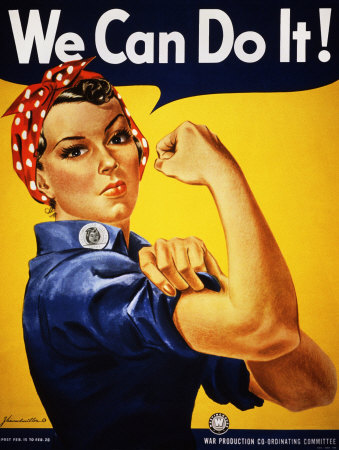
Presidents of the Women’s Auxiliary
Over the years there has been sixteen different president of the women’s auxiliary #50, two presidents were elected several times, Irene Williams and Gloria Gates, the longest service was by Irene Williamson who served as president for 12 years.
– Elizabeth Brown (1937/1940)
– Mrs. Crozier (1940/1941)
– Mrs. Chisholm (1941-/1942)
– Violet Blair (1942 /1945)
– Janet Bennett (1945/1948)
– Irene Williamson (1948/1951)
– Rae Race (1951/1954)
– Bev Hawes (1954 /1956)
– Mary McPherson (1956/1958)
– Peggy Pritchett (1956/1958)
– Irene Williamson (1961/1968)
– Gloria Gates (1969 /1973)
– Bernice Brisbois (1973 /1975)
– Gloria Gates (1975 /1977)
– Shirley Watkinson (1977 /1980)
– Shirley Brodeur (1980/1983)
– Gloria Gates (1983/1986)
– Laurie Maynard (1986 /1988)
– Irene Williamson (1988/1990)
– Viola Montreuil (1990/2004)
Women’s Auxiliary #50 Founding Members
– Helen Baird
– Violet Blair
– Jean Brown
– Elizabeth Campbell
– Marion Dow
– Annie Dunlop
– Margaret Garrie
– Mrs. Hough
– Lynda Smith
– Ethel Wheatley
Women’s Auxiliary known Members
– Donna Adair
– Leona Allan
– Elise Baker
– Francis Boozan
– Jean Connell
– Lillian Eckert
– Teresa Emberson
– Teresa Gadula
– Gloria Gates
– Gerry Ingram
– Dolores Lambert
– Peg Lambert
– Laurie Maynard
– Viola Montreuil
– Doreen McChesney
– Ella Pirie
– Ray Race
– Ethel Saveal
– Irene Williamson
– Audrey Wynn
“Sadly, after 67 years of service the Women’s Auxiliary # 50 closed their doors in 2004. However, the contribution these strong women made over the decades lives on, should be acknowledge and never forgotten.”
Peter Scott
Education Committee
Link to More Images of The Women’s Auxiliary #50
Jack Layton 1950 – 2011
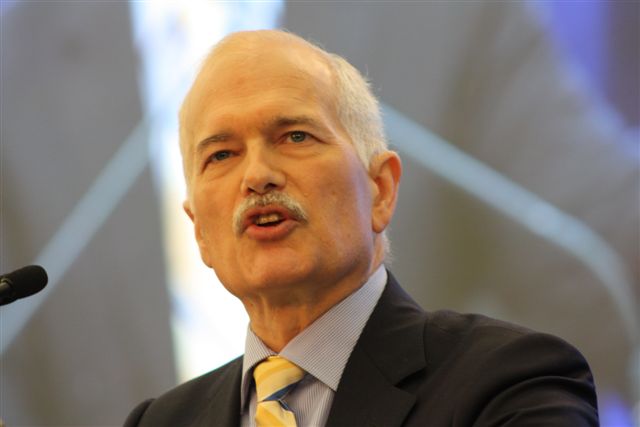
An Open Letter to NDP MPs and all Canadians
August 22nd, 2011
The CAW joins in mourning the loss of Jack Layton, and remembering his social democratic values
(Toronto) – The news of federal NDP leader Jack Layton’s passing has deeply saddened CAW leaders, members and staff right across the country, as we mourn the loss of an inspiring political leader and a friend to working people and all those fighting for justice. Jack Layton had a broad and truly inclusive vision for the country, which he pursued wholeheartedly with enthusiasm and optimism that was infectious. There can be no greater example than the party’s success across Canada in the last election, particularly in the province of Quebec. Jack’s steadfast belief in equality and fairness made him an outspoken advocate for the poor, Canadian families, students, seniors and children. What people saw in Jack was a person who cared sincerely about their lives and would articulately speak up in their defence, on Parliament Hill or wherever the situation found him. He captured our imaginations and encapsulated our hope that indeed as a country, we could do better. He inspired us to believe more was possible.
To NDP Members of Parliament:
Our hearts go out to you as you grapple with the death of a mentor and dear friend. The country is mourning along with you. On behalf of the CAW, we send to you our collective condolences for the untimely loss of Jack Layton. Jack was an inspiring and unifying political leader, unparalleled in Ottawa in recent memory. Surely he must have ignited in each of you a passion for your community and country. To be certain, Jack had great momentum through out the last federal election, but his appeal and strength were also rooted in the ideas he espoused. The hope that Jack Layton drew on in the last election is still with you and your party. The NDP is a crucial voice of conscience for Canada. At Jack’s passing, your voice of conscience is needed more than ever. Your efforts can and will make a difference in the direction of our country. The union looks forward to working with whoever replaces Jack as the leader of the Official Opposition.
To All Canadians:
The country has suffered a terrible loss with the death of Jack Layton. Even many of those who never voted for Jack or a member of his party admired his ideas, his tenacity and conviction. He represented the best of Canadian values – fairness, equality, balance, courage and concern for one’s neighbour. He was but one human, but his persona was much larger. We saw the best of ourselves in Jack and in his vision what was possible for the country. Through out Canadian history, the NDP and progressives have made important advances for all citizens, regardless of their political leanings. As we mourn the loss of Jack Layton, we must also reflect on his vision for Canada and how we can endeavour to make some of his cherished ideas a reality. Among the lessons Jack Layton gave us is the necessity of courage to dream bigger than what others believe to be possible and to pursue these dreams with great determination and passion. Jack’s memory will live on through the tireless work of all Canadians who choose to build a stronger, more equal and just society.
Sincerely
Ken Lewenza
National President, CAW-Canada
Jack Layton – Niagara Falls Review
Jack Layton to lie in State
A Must read Letter of thanks… From Jack Lyton
Jack Layton 1950-2011
Jack Layton remembered as ‘courageous’
Macleans Tribute
Jack Layton dead at 61
My friends, love is better than anger. Hope is better than fear. Optimism is better than despair. So let us be loving, hopeful and optimistic. And we’ll change the world. (Jack Layton 2011)
Images from Jack Layton’s Funeral
Images Jack Layton, Vancouver CLC
Images Jack Layton with Malcolm Allen
Bert Hillier, Boxer, Socialist & War Hero
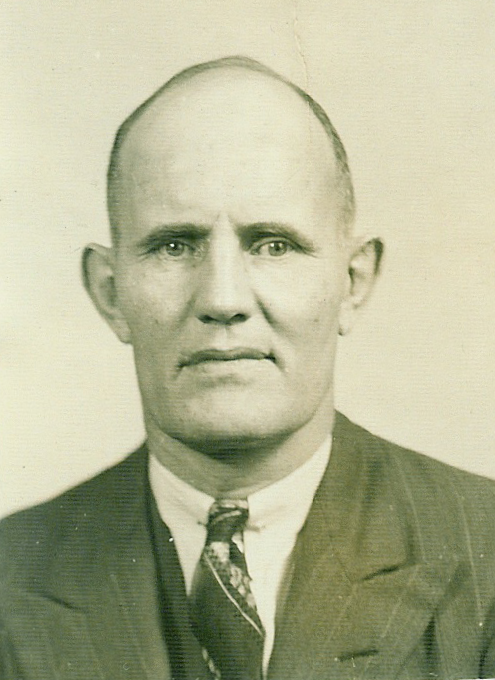
Bert Hillier was the president of UAW local 199 … article to be posted.
Link to More Images of Bert Hillier
Fight Record Bert Hillier
James Connell, President of Local 199
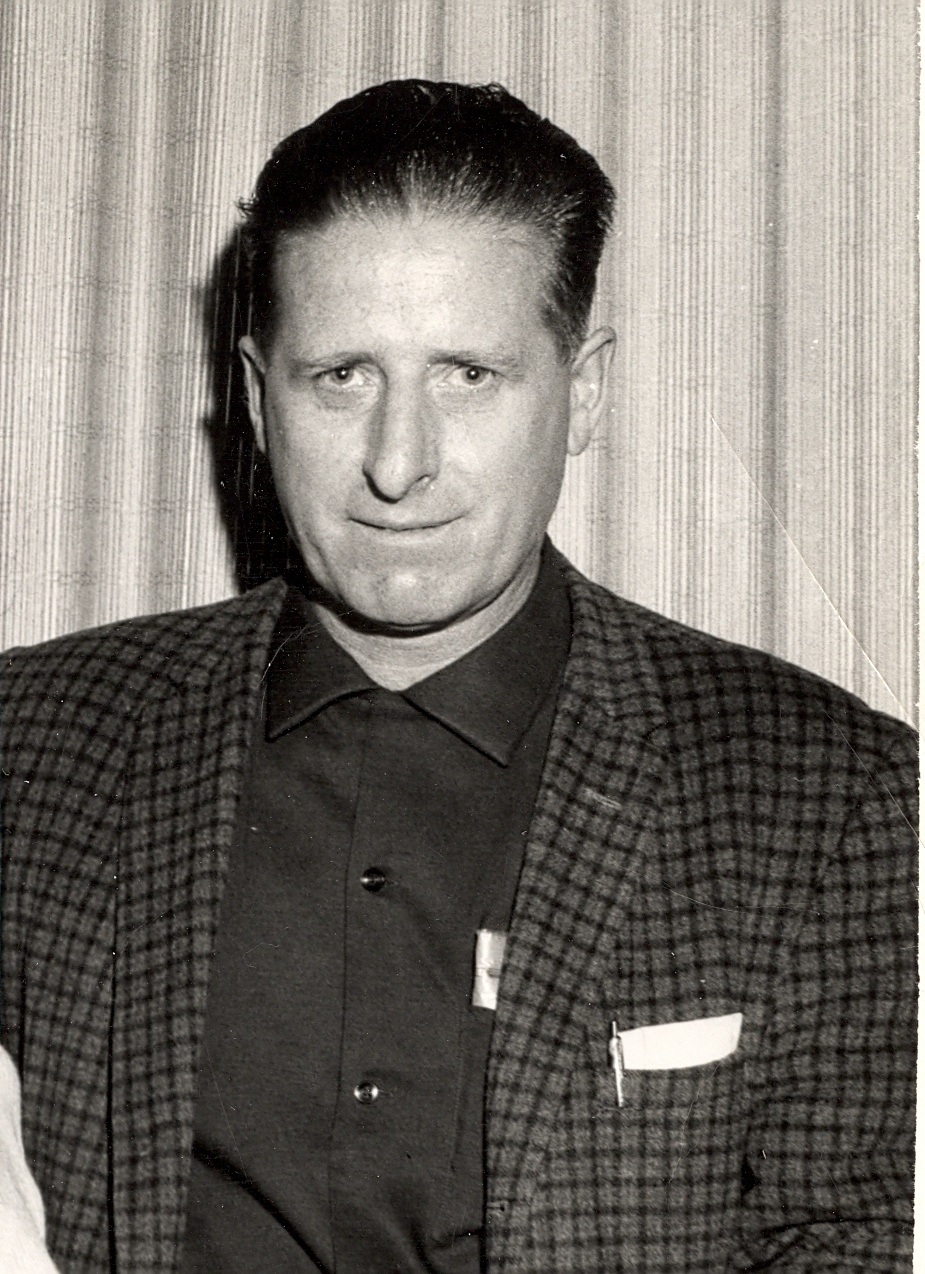
The membership of Local 199 gave their confidence and support to Jim Connell for close to thirty years, Jim in return represented and served the membership very well. Jim was elected President of local 199 for four consecutive terms (1964-76). Being elected President for twelve years makes Jim Connell the longest serving president of Local 199. Gerry Michaud also a past president of local 199 said that twelve years at the top of the house required preparation hard work and commitment; no one was more prepared and committed than Jim Connell.
Jim started working in GM back in 1942 in the foundry’s cleaning room, he also worked in the core room, melt and moulding departments. From 1945-48 Jim worked as a maintenance welder before transferring to tool and die welder. In 1949 Jim transferred to the forge shop where he stayed until he was elected president in 1964.
Jim held a variety of elected positions leading up to his election as President. Serving as; Union Steward in the foundry, Committee Person, Shop Committeeman in 1954, Vice Chairman from 1953 – 64, Canadian GM Council in 1955-76, Recording Secretary, Vice Chairman 1953-64, Secretary, and Treasurer of the GM Council. 1958, and in 1964 Jim was elected President 1964- 72.
When Jim came to G.M. in 1942 you may be surprised to know that union membership was voluntary and we had only about 350 paid members. Stewards were required to collect union dues and would give members a small dues button to indicate they had paid their union dues for the month. Over the next three decades our membership grew because workers saw the advantage of union membership, secondly because of union reps like James Connell who were willing and able to stand up to management and represent the workers. However significant gains in membership did not occur until 1946 when a major break through occurred for workers. Following the 1945 Ford strike the Rand Formula was introduced, which included mandatory dues check off’s. The Rand Formula triggered a series of events that were very good for workers. Justice Rand ruled that if you worked in a unionized environment you would benefit from the Union even if you were not a member, therefore workers should pay union dues. Thousands of workers automaticaybecame dues paying union members. This gave the union the financial security they needed to represent the membership. Funding for education, communication and improved representation was now available. As the membership grew bargaining gains and milestones quickly followed.
In 1976 when Jim was defeated by John Washuta by 600 votes it would be safe to say Jim was very disappointed. Jim however took his defeat in his stride with grace and fortitude. He congratulated his successor and pledged his on going support if required.
In Jim’s last 199 news article as president printed in June of 1976. Jim thanked the membership for their support, crediting the members for his accomplishments. Jim warned the membership that they needed to support the new executive board so that they could be successful.
A few of the bargaining accomplishments that were made during Jims term included, pensions, fully paid medical and surgical, drug program, vision care, nursing home care, wage parity, extended disability, apprenticeship programs, Jim Credited the membership for making these accomplishments.
Jim’s involvement did not stop at the plant gate he was also involved in building the community; developing a Community Health Centre, a Dental Clinic, and building a new union hall was amongst the other significant contributions he made. Jim was recognized for this contribution by having the street that runs parallel to the union hall named Jim Connell Drive.
After his defeat by John Washuta, Jim returned to the plant and worked as a welder until he retired in 1981, during this time he remained active within the community and union.
Jim was a gentleman, intelligent and a hard worker, he dedicated his life to helping others and improving working conditions for those he represented. Jim was a wonderful man and a great leader; many say he was one of our best presidents
Link to More Images of Jim Connell
Gerry Michaud – A Valuable History Lesson
An Interview with Gerry Michaud By Peter Scott
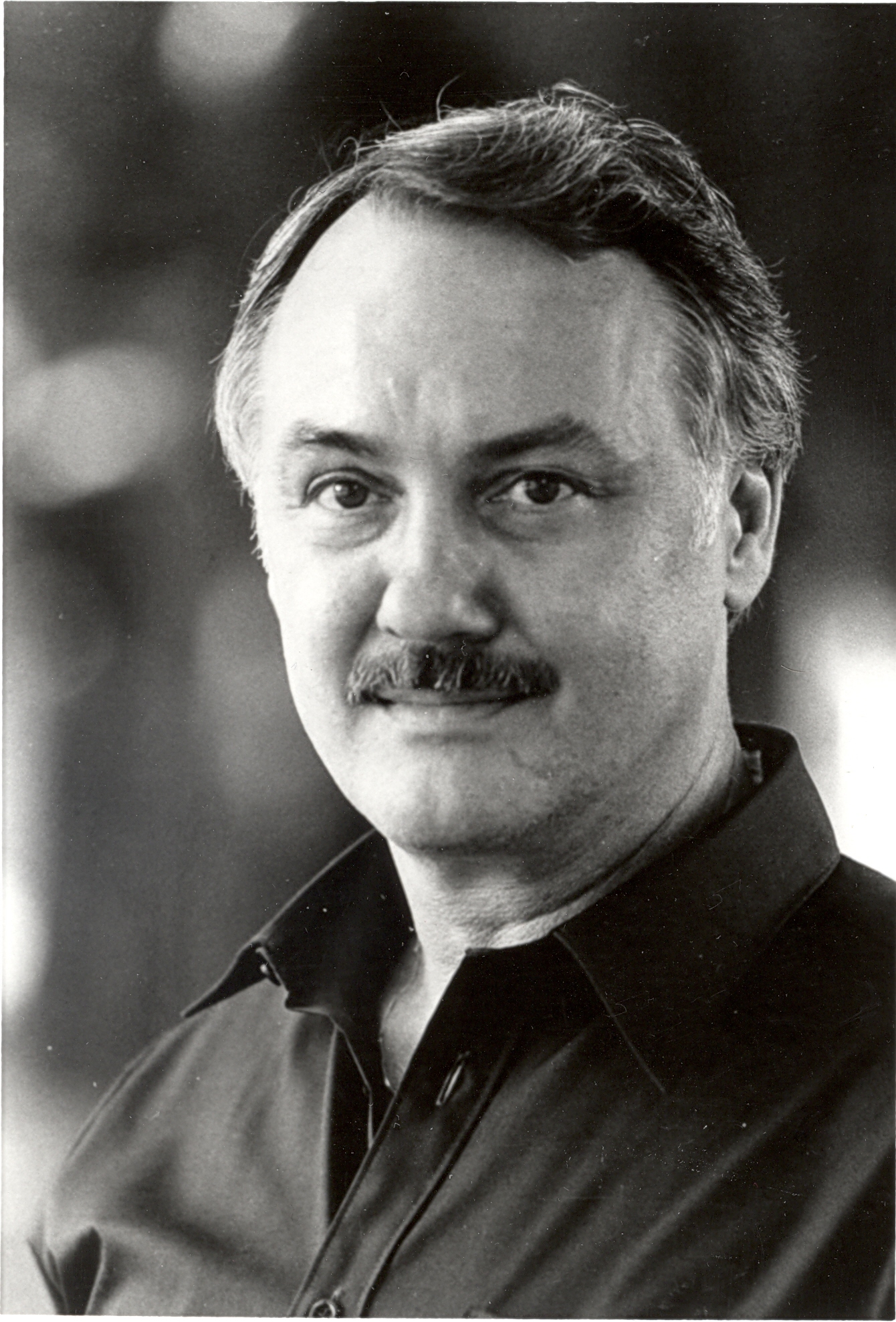
For our 75th Anniversary, I contacted Gerry Michaud to talk about our history. I explained to Gerry I was collecting historical information and photographs for our 75th Anniversary Calendar I was working on. Gerry very graciously agreed to do an online interview with me, which follows. Gerry has subsequently submitted a collection of photographs and articles that can be seen on our website. I would like to thank Gerry not only for his contributions to our archives but also his significant contribution he has made to enhance the lives of our members.
In Solidarity Peter Scott
What Kind of Childhood did you have?
I had a great childhood. We were poor but I never knew it. My dad was lucky to work right through the depression and war years. Because he was blind in one eye and deaf in one ear he was not considered for the military. My mom was sickly all her life due to a damaged heart valve, the result of rheumatic fever as a child. She was not deemed strong enough to marry nor have children as it would kill her. Yet she did marry and I have two brothers, six and nine years younger than I. When the Union negotiated a drug plan my father had some disposable income for the first time in his married life. By the time I was twelve my father had scraped together $900 for a cottage on leased land at Jones Beach. I grew up swimming in the Lake and the Welland Ship Canal, playing sandlot soft ball and later football in high school. When I was 14 my dad sold the cottage and we moved to Thorold. I was a King’s scout and was lucky enough to be selected as one of 32 Canadian Boy Scouts to travel to England and attend the Coronation of Queen Elizabeth. (We became Queen Scouts then). I attended Notre Dame High School in Welland and went to grade 13 at Thorold High long enough to play football before I started work at the Ontario Paper Co.
When did you get involved with the union?
As a Paper Maker I did not aspire to union office but I did attend every union meeting in order to pay my dues (no check off at the Ontario Paper then) and was a vocal participant. When I started at General Motors I was in the foundry. In those days there were two caucuses; the Unity Caucus and the Walter Reuther Administration Caucus. The Unity was led by Gord Lambert and the Reuther Caucus was almost defunct. It had only two members in office. Eric Cooper as Financial Secretary – Treasurer and Eddie Child as a committee person in the Engine Plant. There was a third Al MacLean who was a committeeperson in the Foundry, but he defected to the Unity Slate in order to get his grievances settled. He resigned after getting a physical beating while traveling to Port Elgin by bus with the members of his new caucus. In those days I thought Communists had three heads and so when Eugene D’Antonio, who I had been in Boy Scouts with, asked me if I liked the way the union was being run I said no. Orchestrated by Lorne Franklin from the Engine Plant, Eugene, myself and about eight others walked into a meeting of the Reuther Caucus, ran for office and took it over. Following Walter Reuther’s death we changed the name to the Blue Slate Caucus which reflected the colour of the paper we printed our leaflets on.
What was your first Elected Position?
In 1971 I was elected as afternoon shift committeeperson in the foundry, representing the molding lines, melt department, tow motor drivers on the ramp, the pattern shop and the core room. Dale Martin was my first alternate. Dale was a good friend. He had run on the Unity Slate but lost to our candidate who turned around and resigned after his first grievance call as he could not handle the pressure. I had Washuta appoint Dale who then joined the Blue Slate and was a terrific alternate. Carlos McCoy from the Unity Slate represented the Cleaning room. We put aside our differences and worked together to make sure the foundry workers had good representation on the afternoon shift. In my opinion Carlos was a good committee person.
What were the working conditions like when you first started?
I quit my job at W.S. Tyler’s to work at General Motors. In 1965 the difference of $20 a week was a lot of money to a father who was the sole support of his wife and four children. I went from a steady day job and a clean working atmosphere to the foundry on Three Line. Objects at the extreme end of the line were somewhat hazy due to the dirt and dust. I worked at the clamp job and later on shakeout. I took the opportunity to take my wife on a tour of the foundry. When we came to the shake out job and told her that was what I did she was horrified. The dust was so bad that after eight hours on the job my own mother would not have recognized me behind the dirt and grime that ate into the pores of my skin and eyes. In those days we had 10 minutes an hour of “environmental relief”. Thanks to the solidarity we had with one another we were successful in turning that into half an hour on and half an hour off within a period of a couple of years. I learned not only the value of a well run work stoppage but also how to conduct one which paid off a few years later when I was a committee person.
What was it Like For Minorities and women in the Plant?
There were only a few minorities in the plant when I was there. They were obviously discriminated against. An example was Everett “Pudge” Dawson, a black man working in the foundry who had a grade 13 education at time when most of the superintendents in the foundry didn’t even have grade 10. Pudge was never considered for a management position. The company’s loss was the union’s gain. Pudge represented us at the International UAW Foundry Council as well as a on number of committees and was the editor of the local union paper for a number of years. Leroy Bell was another example of a good man being ignored. Again it was a blessing for the union to have such a capable person as a union activist. There were no women in the foundry. They had been laid off out of line of seniority years before just because they were women. One of the things that John Clout was successful in obtaining at the bargaining table was the restoration of their pension credits for the entire period that they were unfairly on lay off. When women first came back into the foundry there were problems with some of the jobs that were just too heavy for them. At a bargaining committee meeting, because there had been complaints that the women were getting “cushy” jobs, a number of committeemen took the position that if they couldn’t so the job they should be let go. “If they want equal rights they should have be willing to do equal work”! I stood up and said I agreed. However if we had a man that was around 130 pounds that wasn’t strong enough to do the job, he should be let go too. My ruse worked and the complainers looked bad and backed off. We then agreed that if the job was too heavy to be done safely then we should negotiate hoists and other aids. It wasn’t long before the hoists were on the line in the cleaning room which was where most of the problems were. The women became accepted and the complaints died out.
Who was the president when you started in the plant?
When I started in the plant Jim Connell was president. Jim was in office 12 years, he was and still is the longest serving president in our history and deservedly so.
Who were the leaders that you looked up to?
Gord Lambert, Jim Connell and Eric Cooper, Denis McDermot and Bob White were leaders I really respected. While I was in a different camp from Gord and Jim we were never bitter with one another and there was mutual respect and admiration. I remember being terrified when as a rookie committee person I got a call to represent Gord after he was back on the job after being defeated as Plant Chair, a position he had held for 18 years. He just had a simple question and was a real gentleman. We sat down and discussed a number of issues. I think Gord was feeling me out to see how I felt about things. Other than the fact that he was a member of the Communist Party of Canada and I was a New Democrat, we saw eye to eye on most things. He was certainly a barn burner of a public speaker!
I gained a lot of respect for Jim Connell when, even though we were in different camps, he had me go to the St. Catharines Standard Print Shop to put together a list of dentists who would cooperate with us by charging our members the 1976 fee schedule instead of the current one. Even though the document was under my name, Jim felt it was too important to do as an ordinary leaflet and I always respected him for that.
I watched Denis McDermot closely. Not only was he the most articulate speaker I had heard to the time, (Victor Reuther was the only one that in my opinion was better), but I learned a lot about how to run an effective meeting by watching him.
Bob White, despite the hard times I sometimes gave him, was my hero and in my opinion, the best thing that ever happened to the labour movement in Canada.
After I became President I was lucky to work with two great International & later National Reps, Bill Marshall and later Jim Porter They had very different styles but they were both very effective and I learned a lot from both of them. Jim was my favourite. He would always go the extra mile for workers and we became life long friends.
We walk across bridges built by those who passed before us, what does this mean to you?
The gains, both contractual and political, made by working men and women didn’t come in one fell swoop. The one page first agreement between the UAW and General Motors is a far cry from the several thick volumes that contain the Master & Local Agreements and benefit plans that contain the rights we all enjoy today. The long, difficult strikes our predecessors were forced to wage meant that we didn’t have to. The longest strike I was ever part of was the 1970 strike against General Motors that lasted 13 weeks. This is a far cry from the 6 months strike in 1955. The longest strikes at General Motors in modern times has been only 2 weeks and one of those was only because General Motors got the wrong message from the American leadership of the UAW. Whether it is favourable labour legislation or good contracts, each one is another brick in the foundation of gains for workers.
Today we often hear comments about The “good old days” unions were stronger and more militant and “Gerry Michaud would not put up with that” care to comment.
I’ve heard about the “good old days” but this is the first time I have heard that “Gerry Michaud would not put up with that”. It is difficult and often unfair to make these kinds of comparisons. Unions could not have survived had the members been less militant. The benefits we enjoy today are not the result of blind militancy, but rather intelligent militancy. You have to know when to fight and how to stay alive to fight another day. I don’t think it is fair to say what Gerry Michaud would have done if I had been under the same pressures that union leadership is under today.
Doug Orr has said that things are much different today than they used to be.
I really can’t comment on that one. The problems have always been the same, layoffs, fear of layoffs or plant closure, greedy corporations and right wing governments who see big business as their friends and workers as pawns. We have always had to fight for what is rightfully ours. General Motors spends three months negotiating a contract in Canada and three years figuring out ways to chisel and renege on what was negotiated. That is as true today as it was in the past. Our membership has more formal education than most of us had in the past; they have certainly had to struggle to hang on to what they have, but things haven’t changed that much. Remember PPH’s. Times for workers are always challenging and always will be as long as profit is the sole motivation for employers and re election funds the prime concern of governments wanting to be re- elected.
What makes a good trade unionist and effective leader?
These are two very different questions. A good trade unionist is not necessarily an effective leader nor is an effective leader necessarily a good trade unionist. There are many advantages to holding office in a large local such as ours. In the past I used to struggle with people’s motivation for holding office as some of them were there for personal gain rather than an honest desire to serve the membership and their community. I finally came to the realization that it was not my place to question the motives of those who held office but rather part of my job was to make sure that they did theirs.
I guess my answer would be that in my view a good trade unionist is one who sincerely works at trying make a difference in bettering the lives of working people and an effective trade union leader is one who can inspire that attitude in others.
What was the most difficult decision you had to make?
When I was first elected president the members lounge was losing over a thousand dollars a week of membership’s money. The decision to close it and the process of convincing the executive board and the membership was probably the most difficult decision I had to make. I am proud of the fact that despite malicious opposition from certain plant politicians we were able to conduct a secret ballot that saw an over 95% vote in favour of closing it down; and most important, we kept our employees on full pay and benefits until we found them good paying jobs in the various units of the local union. To ensure that those who strived to cause unrest didn’t stack a meeting some day and vote to reopen the lounge I proposed that it be turned into a Retired Workers Centre. No one would have the political will to kick out the retirees to reopen the lounge. The happy ending was that those people came to recognize the necessity of the closure and became without exception friends and political allies and the retirees had a well deserved center for their activities.
A second decision was one made in my capacity of Chairman of the Blue Slate Caucus I decided that it was important enough to risk splitting my caucus by extending the hand of friendship to the newly elected Chairman of the G.M. Bargaining Unit, John Clout. That decision did cause a split in the caucus but I never regretted it. John and I working together were able to get more benefits for the members than we ever would have apart.
Back in 1965 when the Auto Pact was signed were you happy or concerned about the trade deal? I first started in the plant in September of 1965. In the summer of 1966 I was laid off six weeks for model change. Two weeks before I was to return I received a notice of indefinite layoff. Obviously at the time I didn’t think the Auto Trade Pact benefited me. The worst part was that there was never a mail out from the local union advising those of us who were laid off of our seniority rights, especially the reinstatement provisions following a return to work, nor were we advised of our rights to collect special benefits from Unemployment Insurance, (TAB), during a layoff resulting from the Auto Pact. I swore that if I were ever in a position to do so I would ensure that workers would always be aware of their rights at times of layoff.
What was your role in the 1985 split away from the UAW
Prior to 1985 the members of the master bargaining committee crisscrossed Canada & the United States dogging the heels of UAW President Doug Fraser and Vice President Owen Beiber who headed up the G.M. section of our union. At every location our job was to convince our American counterparts to resist opening up the collective agreement early in order to give concessions. Phil Bennett who was the Chair of the master committee was a reluctant public speaker and asked me to speak in his place to put forward the Canadian point of view. While we were successful in convincing them on two separate votes, Fraser kept at it until “they got it right”.
Following that Brother White invited me to a caucus meeting of the International UAW Administration. I spoke at that meeting in an attempt to convince the caucus to open up the floor for a meaningful discussion on “take aways” and the opening up of agreements for the purpose of giving concessions to the big three. I was totally disgusted at the attitude of the American leadership and I advised Bob White that I never ever wanted to be part of the International Caucus again. From that point in time I lobbied for a Canadian Union.
Following 1984 negotiations I got a motion passed at Canadian Council to the effect that we investigate forming a Canadian Union. Brother White came back with a recommendation to form a metal workers federation. It never got off the ground and after he failed in an attempt to get the International Union to give the Canadian section of the union more autonomy, Bob recommenced to Council that we form a Canadian Union. Like others I spoke in favour of the recommendation and did everything I could to encourage the leadership of local 199 to support it. Following the negotiation of the split we distributed several leaflets in the plants and then took the issue to the General Membership with the recommendation to support the formation of a Canadian UAW. The recommendation was passed overwhelmingly.
Following the meeting, Brother Bill Orr who had never supported a Canadian Union, demanded a special meeting to discuss and vote again on the issue by means of a secret ballot. There was never a demand for this sort of meeting from any other source, but Bill was a very popular Financial Secretary and had a lot of support within the membership. I was forced to hold a special meeting for the purpose of making the decision to split or not once again. The meeting was well attended and the only two speakers were Bill and I. For one of the few times in my life I put a speech down on paper rather than speaking off the top of my head. The future of the union in Canada was at stake and Oshawa plant politicians were watching closely. If we were to vote to stay with the UAW then they had ammunition to do the same. If St. Catharines and Oshawa had stayed with the UAW there would be no CAW today. Bill Orr and I were the only two speakers and the vote was very close. If I recall correctly it was around 53% in favour of forming a Canadian Union. To close for comfort as far as I was concerned. In fairness to Bill he was not part of the bargaining process and didn’t see what we saw in Detroit and in Toronto and so his heart was still ruled by our old relationship with the UAW, which in its day was a great boon to workers here.
At our first Constitutional Convention I had the honour of being elected as a Trustee on the first National Executive Board of the CAW. At that convention I was also privileged to chair the Constitutional Committee, an onerous task as we had to write out the new constitution that would govern our union for decades to come.
Public opinion is that Unions should stay out of politics, can you respond to this opinion.
Unions who take the position that they should stay out of politics don’t deserve to represent their members. If nothing else, the Conservative Bob Harris government showed clearly how much and how quickly we can lose gains through the legislative process. Unions and their political allies made many legislative gains in Employment Standards, Workers Compensation, Employment Insurance, Universal Pensions, Medicare, Human Rights and a lot of other areas. Many of these gains have been lost or weakened by the same process. It is only through intelligent and militant political action that we can hope to keep greedy corporations and moneyed interest from destroying not only the gains that workers make at the bargaining table but from destroying the very vehicle that gives workers the right to bargain collectively.
Affects of FTA and NAFTA agreements on our industry. Preceding the negotiations of the first FTA, our union lobbied every municipal government in Ontario for their support in our stand against Free Trade. In the Niagara Region I made an appeal to each municipality on behalf of our union and we were 100%successful in obtaining their support. Of course there were individual members of some councils who did not support us but the majority prevailed. Unfortunately every thing we said would happen under Free trade did happen. Companies no longer had to have a plant in Canada in order go have access to the Canadian market and so rationalized their industries by closing plants in Canada and moving the jobs to the U.S. The jobs that replaced these good paying jobs that made it possible for a worker to raise his/her family were minimum wages jobs. A new word came into the use, “McJobs”. We lost the Auto Pact and the workers in the auto industry today are about half of what they were before Free Trade.
My opinion of the auto industry today. A far cry from what it was. Not only have we lost jobs, but the big three have also lost a large share of the market. The sad part is that it was General, Motors, Ford and Chrysler who brought the loss of market share about because of their greed in refusing to invest heavily in quality and engineering. Finally they were forced to because the quality products manufactured by the Japanese were selling so well. Their greed also put off the building of smaller, fuel efficient vehicles as long as they could maximize profits by making big gas guzzling profit makers. Again, after they lost business to those who did, they never got it back. Until such time as the Canadian Government has the guts to legislate Canadian content and environmental rules as well, we will continue to lose jobs to other jurisdictions.
What are the Challenges for the future?
I don’t have a crystal ball, but I say again we have to be involved with politics. Canadian governments have to legislate for the benefits of their citizens not the corporations. Today corporations are using a well thought out strategy to increase their power over governments and workers both. We are still a good market for the world to do business with, but unless we elect governments who will have the balls to govern rather than beg for reelection funding from the rich, things will get a lot worse for workers and their families. We need more workers in government and fewer lawyers and business people. Our biggest challenge is to educate our members, our families, neighbours and the community at large of the methods being used to lull people into a sense of helplessness and acceptance of the way things are. We need to challenge people, to fight apathy and all its ills.
What 199 Presidents have you known?
I have known George Bennett, Bill Race, John Ideson, Jim Connell, John Washuta, John Clout, Ron Davis, Gabe McNally, Wayne Gates and Ron McIntosh.
George sold out and became a foreman in the G.M. Core Room, Bill Race was chair of the Retired Workers Chapter when I knew him. He a small man with a big heart and a good trade unionist. John Ideson was an extremely intelligent individual, but essentially a loner. He was not what would be called a team player today. He was however known as “Mr. Labour” in his time as president of both the local and the St. Catharines and District Labour Council. When we took over the bargaining committee in 1971, Washuta appointed Brother Ideson as the S.U.B. rep and it was in that capacity that I got to know him. Jim Connell was president when I started work at GM. He was an excellent negotiator and truly had the best interests of the membership at heart. I learned a lot from Jim. He had a keen sense of humor and we became good friends after he was elected as chair of the Retired Workers Chapter. John Washuta was elected chairman of the G.M. unit in 1971 and President of the local in 1976. I helped John get elected in 71 by writing a lot of his leaflets and some of his chairman’s columns in the 199 News after he was elected. I did not support him for president. John was one of the hardest workers I ever met, but during his term of office as president he neglected his duties to the G.M. unit and felt his roll was to manage the union hall lounge and banquet facilities despite the fact that we had a Hall Manager to perform this function. John was also a city alderman and a very good one. However I did not like what he had done to denigrate the office of President and so I ran against him and defeated him and Sandy O’Dell on the first ballot.
When I made the decision to accept the directorship of the CAW Family Education Centre (another very hard decision), I held discussions with Ron Davis and John Clout as to who would succeed me. John and I had worked very closely and when I asked Ron who people would see as the leader once I left, Ron admitted that it would be John. I then asked Ron if he would consider running again as vice president and support John for the presidency in the coming election. To his credit Ron agreed to this. John was a credit to the union and despite our differences at times, he always took the path that was best for the people he represented and I felt he deserved to be president. He was elected to the National Union Executive Board, was appointed to staff and retired in St. Catharines. His death was premature. Lung cancer is a terrible thing and I miss John and our friendly rivalry.
Ron Davis and I go back to 1971 when he was elected as Back Shift Committee person and I as afternoon shift committee person. Ron went on to become the foundry shop committee person and the first full time vice president of the local union. He was the best vice president anyone could ever ask for. As president he was the first president in our history to retire while still in office. That shows you how competitive the politics were in our local union.
Gabe MacNally was a committee person and shop committee person prior to becoming president. Gabe was on of those who left the caucus when John Clout came on board. After Brother Bill Orr went on staff I told Gabe that it would be a good idea for him to come back as things were moving and I thought him too good a man to be sitting on the sidelines. Gabe came back and thanks to his abilities became president of the local and from there was promoted to the staff of the National Union. At the time I write this he has told me that he intends to retire next year. (Gabe McNally died July 15th 2008)
Wayne Gates used to play softball with my son Michael. He was a good athlete and for years served as back shift committee person at the Ontario St. Plant. Wayne was always cocky and told me once he thought he could do my job. I guess he was right because he did, defeating Ron McIntosh, which I am sure did not endear him to Ron. I thought Wayne did a good job in representing the local in the community and also at the bargaining table. Wayne has remained active following his defeat to his old nemesis Brother Ron McIntosh. Most recently he ran for federal office as an NDP candidate in Niagara Falls. ( Wayne was reelected to the position of President and is currently on the Niagara Falls City Council)
Ron McIntosh is another old caucus brother of mine who has served this union well, not only as president, but in a number of other capacities including benefit rep. While I am no longer in St. Catharines, I do keep abreast of things and from all reports Ron is a good president and I know from past experience he is an excellent trade unionist. I don’t know how many more presidents of my local union it will be my pleasure to know, but I am proud to have known so many of my predecessors and successors. (Ron was defeated by Wayne Gates and retired in January 2009)
Who was the most influential person in your life?
That’s easy, my mother. She taught me early in life that people were to be accepted as you found them regardless of what other people thought and that things like race, colour or religion didn’t matter. I was blessed in being raised as free of prejudice as was possible in those days. In later years I had to learn to be a feminist and to also recognize that homosexuality wasn’t a matter of choice anymore than is heterosexuality. All of the traits I possess that can be considered good were either instilled in me or encouraged by my mother. She was really something. I could easily write a book about her.
What is your most satisfying accomplishment?
The sharing with Marlene in the raising of four fine children who grew up to be responsible, caring adults. As a member of local 199 it was having a role in forming the Canadian Auto Workers and being a member of the first CAW Executive Board.
Do you have any regrets?
I have no regrets concerning any decision I have made in my life. Based on the experience I have gained over the years, some decisions might be made differently, but the ones I made were always to the best of my ability at the time.
How do I wish to be remembered? I am conceited enough to hope that I would be remembered, but pragmatic enough to know that in a few short years I will be only a name and a face in a faded photo. If I am remembered at all, I would feel good if it were for having played a role in improving the lives of workers, their families and the community in which we live.
Last question, Do you have any words of wisdom for those that follow?
Age does not make one wise… The only advice I would offer is to do the best job you can for every member who asks for your help, do the right thing even it isn’t easy, and to live every day of your life as though it was going to be front page news the following day.
Over the past five years I have maintained regular contact with Gerry Michaud, although we don’t meet in person very often we do chat on line. I usually contact Gerry if I want to kick an idea around or if I am looking for some information about the local union history. This year my pet project is to update our website I will certainly be asking for his help.
“I consider Gerry to be a good friend unfortunately we were born a few generations apart. I often wish we could have worked together, I would have liked that.”Peter Scott
Link to More Images of Gerry Michaud
John Clout wasn’t just a Fair Weather Leader
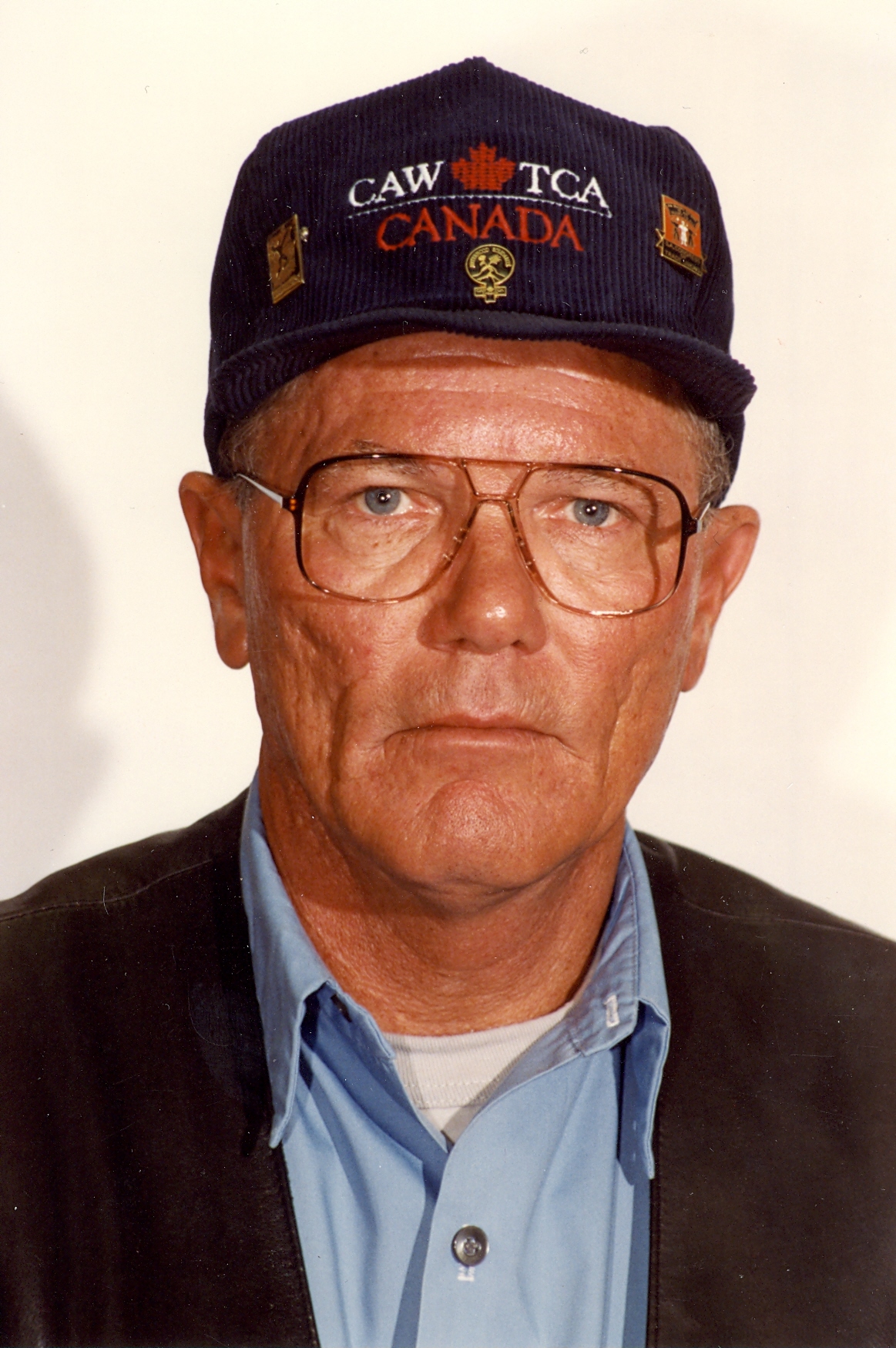
John Clout was elected five times to the position of GM unit Plant Chairperson in St Catharines. John was first elected in 1980 and was re-elected four more times in, 81, 84, 87 and 1990. In 1988 John opted to run for President and was elected in the spring of 1988. After two years in the office, and at the insistence of many, John resigned, to run once again as the GM Unit Plant Chairperson. During that period John headed the Local Negotiating Committee in 1982, 1984, 1987 and 1990 negotiations and was a member of the Master Negotiating Committee.
Back in 1987 when John was the Chairperson of the Master Negotiating Committee we made several historical gains on the pension front. The CAW negotiated indexed pensions, 25 and out for all foundry workers (including the Pattern shop). At this time the bargaining Committee also resolved the 20 year old problem of pension credits for women who laid off out of line of seniority back in the 1960’s, and also won parity for the Precision Grinders.
In 1982 Canadian workers were faced with going to the Bargaining table alone for the first time in their history. American GM workers had reopened the 1979 Agreement and signed a massive concessionary contract. As well, thousands of Canadian GM workers were on permanent layoff. Under these extremely difficult times, and with the support of the total Membership, the CAW was able to beat back most of the U.S. concessions and sign a contract without a strike. When the Welland Avenue Plant was closed John was the Chairman, John fought relentlessly to have it reopened.
Clearly John Clout was a well recognized and well respected vocal spokesperson for the rank and file. Some may not have always agreed with his politics, but he was undoubtedly a very able worker tactician. Bob White realized this when he picked John to replace Gerry Michaud on the NEB and why he was re-elected to the NEB, as Trustee, at the 1988 CAW National Convention in Halifax.
After Bargaining in 1990, John was put on CAW Staff as a National Service Rep. Sometime later the division of the national assignments was also altered, to give John GM in St. Catharines. During his career John was involved in countless issues, too many mention in a short article. Which included; human rights and harassment in the workplace and the Union, Local 199 Membership electing their Shop Committee representatives to be their bargainers, equal rights for everyone, ensuring that one of the two top spots in the Local 199 Bargaining Committee was from Skilled Trades, job security, voluntary layoffs, income security, indexed pensions, over and above wage increases for the trades, a strong health and safety advocate, and mostly every campaign, forum, rally and Queen’s Park action that occurred.
John Clout and his wife Irene and their three children were always permanent fixtures in the annual Labour Day parades.
John Clout’s record speaks for itself, John was a firm believer that a list of credentials meant nothing, if you didn’t do anything with them. He was indeed a very forward thinker, who strategized on the best course of action to reach a particular goal. After laying out the approach, he would fight with his all to reach that end on behalf of workers and their families.
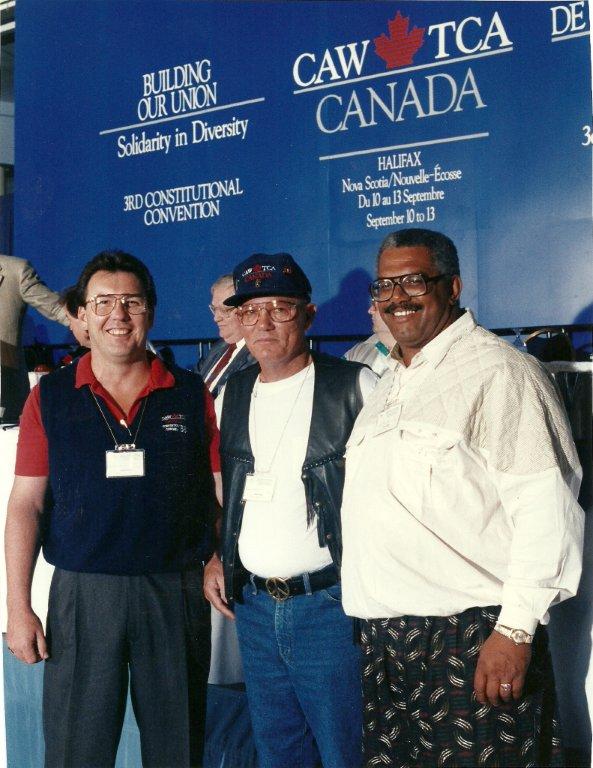
Dan Boone (Skilled Trades Chairperson and National H & S Coordinator) says this about John Clout…….
“I have never met and probably never will meet another individual like John Clout. He was my mentor in the Labour Movement . There were indeed others who were impressive in their roles and capabilities, like Leroy Bell, for example, our Human Rights Rep. and CAW Council member, who remained steadfast always vocal, on his beliefs. And Bob Nickerson, our National Financial Secretary, who had “fire in his belly” when advancing worker’s issues. But in my mind John was the epitome of a workers representative. John Clout was the total package, the two most important things in his life was, his family, representing workers and their families. John did both with a lot of passion.. He was the biggest reason that I became involved in the Union and I owe a lot to John. My good friend is sorely missed.”
A closing thought about John and his determination that you may not know, it took John 17 years of countless elections to get elected to his first position and as it happened, it was GM Unit Chairperson in an election he never expected to win in 1980. Now that’s determination.
John Clout was a powerful and strong leader who fought endlessly for the workers he represented
Link to More Images of John Clout
Pudge Dawson
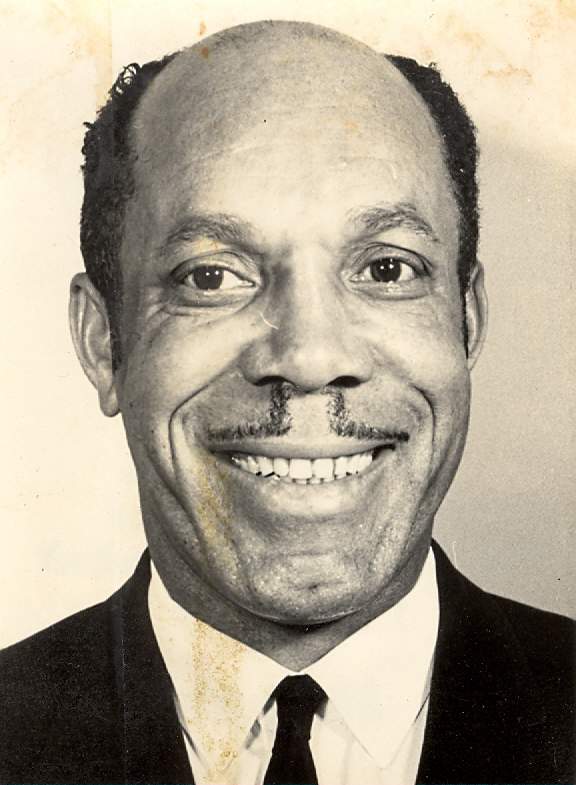
Pudge Dawson started working at McKinnon’s industries in 1938 until he retired in 1976. In 1973 Pudge made a speech at the opening ceremony of the New Union Hall and again at our 50th anniversary. Following is a copy of the speech which offers some perspective of the working conditions in the plant.
“As Time Goes By” By Pudge Dawson – September 1st 1973
“Nearly 40 Years ago, a handful of spirited and dedicated workers resolved to build a union, and to work with their fellow men. This building is living proof of one of their many accomplishments”
In 1973, as a member of the Executive Board of Local 199 U.A.W., I was assigned the task of making arrangements for the dedication ceremony of the opening of our new union hall. The above words were written by me to commemorate that memorable occasion. I cannot think of words more appropriate to tie in with the 50th anniversary of our union. These words are enshrined in bronze in the main foyer of the Union Hall as a tribute to the workers of the past.
As time goes by, it becomes increasingly harder to recollect and convert into words the trials and hardships we older workers had to endure to help make a better future for those that follow.
I grew up in Toronto during the depression era and I came to General Motors in St. Catharines in 1938 at the age of 19. It was the first full time job of my life. My starting wage was 45 cents per hour. A low figure by today’s standards but at that time, it was a princely sum because in those days, one had to survive. I was assigned to the Foundry Core Room and I spent my entire G.M. working career there until my retirement in 1976. It was rough, dirty and smoky. The gas from the hot iron, the ovens and baked cores had your eyes watering steadily. Your ears and teeth ached. The heat was unbearable. It was just plain miserable. Many of the workers actually passed out.
Along with the terrible working conditions, we had no medical coverage, no pension rights, no grievance procedure, we had nothing but a job.
It was no miracle, no stroke of luck that we gained what we have today. The stalwarts of our union; the Lamberts’, the Burts’ and the Reuthers’ finally convinced G.M. that our union was here to stay.
It has been a long, rough, rocky road but Local 199 has preserved.
May our union still strive for more and better things for all of us. May the future bring the ultimate in wages and working conditions so that workers everywhere can enjoy the fruits of a happy and prosperous life.
Pudge Dawson
September 1, 1973
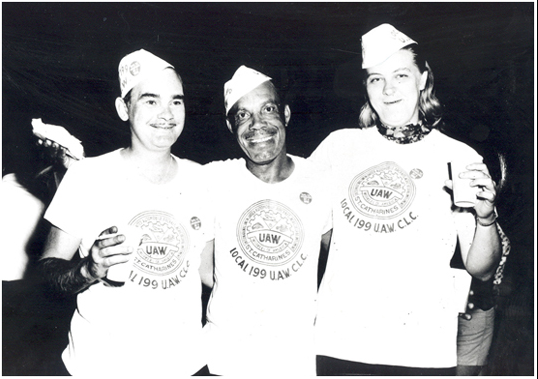
A tribute to Gordie Lambert
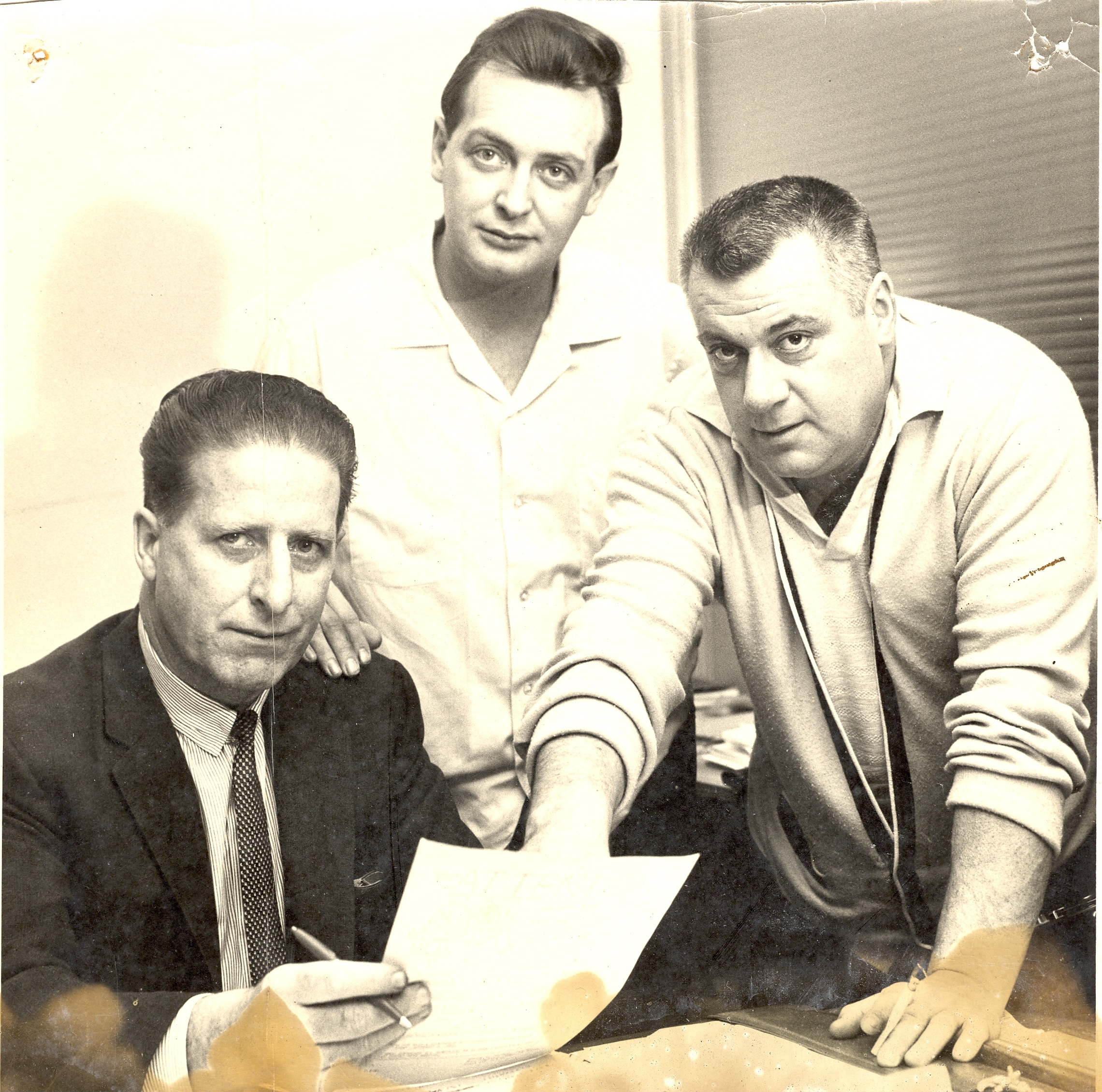
Gordie Lambert started working at McKinnon’s industries in 1940 until he retired in 1980. (Left to right – Jim Connell, Ron Adair, Gordie Lambert)
On January 1st 1980 Gordon L. Lambert Retired from General Motors. Gordie worked at General Motors for 40 years, 39 of them were in an elected position of one kind or another. For 18 years from (1953 -1971) Gordie represented the membership as the GM Plant Chairperson.
Gordie was known across Canada for his fiery oratory and his ability to stir up a crowd in much the same manner as an old time preacher. It has been many years since Gordie’s booming voice could be heard over the noise in the foundry, while he blasted a supervisor, but many of our retirees still recall those days.
Eddie Child recollected that when he was the off shift committee person he had to call Gordie a few times at one and two in the morning to deal with work stoppages and walk outs, this was a regular event in those days. Workers would quite often just stop working and walk off the job. Over a six year period Eddie had to call in the plant chair in at least eight times for such stoppages. Gordie never complained and would come in to work in the middle of the night to deal with the issues, settle things down and get everyone back to work quickly. In doing so Gordie averted what could have been a volatile situation and could have resulted in lost time for a lot of our members.
Len Harrison said that although Gordie Lambert and I were political rivals for many years, I think it is fair to say we respected each other views and opinions. We certainly agreed upon most issues that were fundamental to the union movement, even if our political view was different.
After 18 years as GM Plant Chairperson in 1971 Gordie was defeated by John Washuta, John Defeated Gordie again in 1974 for the position of Vice President. In his 40 years at GM Gordie held a variety of positions, Union Committeeman, Trustee, GM Plant Chair, Chairman of all plants, Vice President of Local 199, Delegate to UAW Council, Canadian Labour Congress President of the St Catharines and district labour council.
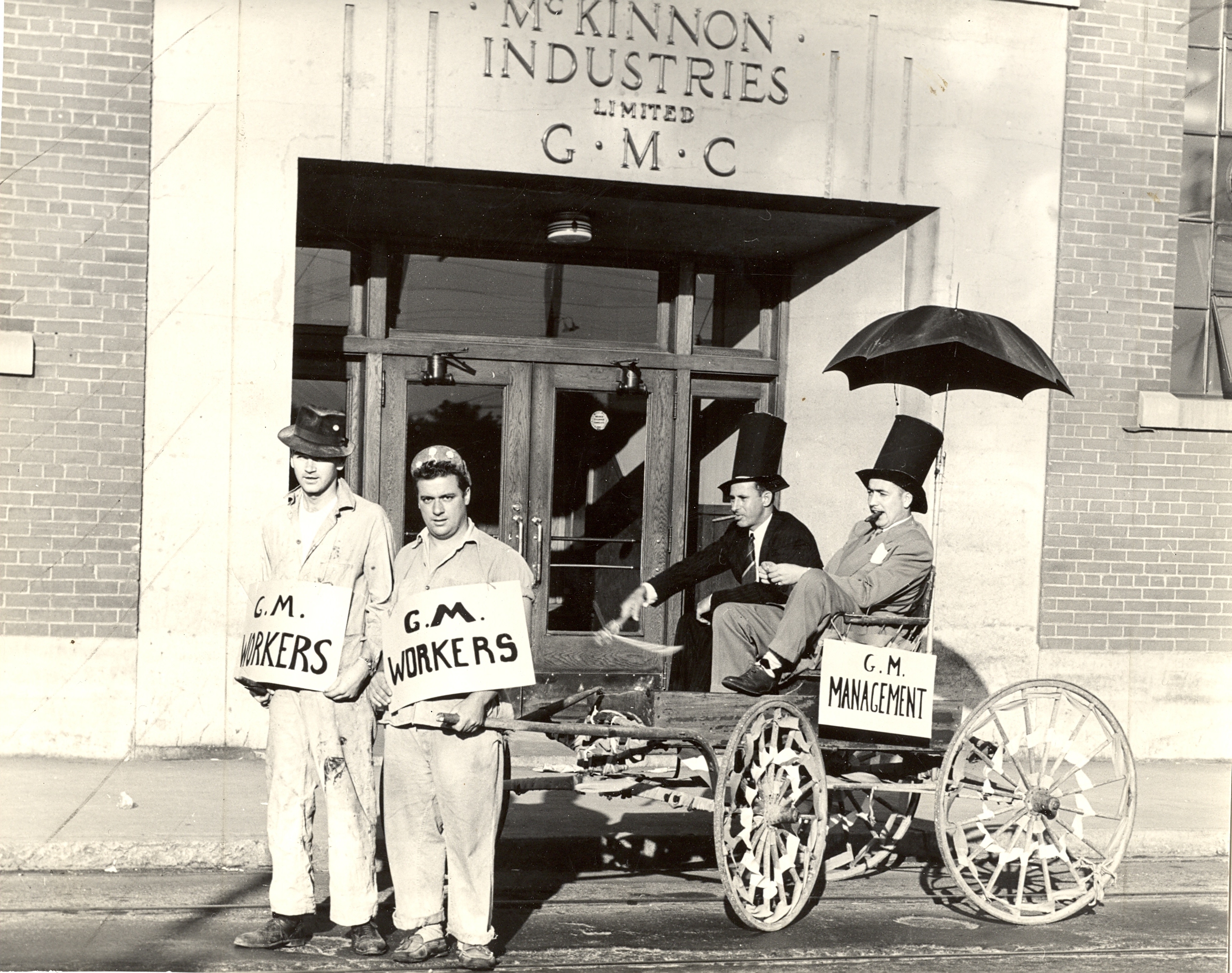
On one occasion back in 1948 Gordie created quite a commotion. During a strike to boost the workers moral, Gordie Lambert, Porky Bigford, Lloyd Hawke and Ken Brisbois, stopped traffic on Ontario Street. Outside the main entrance of McKinnon’s Industries, Gordie and his crew, two dressed in top hat and tails representing management, two dressed in coveralls representing the workers, took turns riding up and down the street in a horse buggy. Initially the workers pulled the cart and management rode. To the cheers of all the workers present the roles were reversed, Gordie and Porky Bigford, sat back, smoked 25 cent cigars, as management took their turn pulling the workers!
Gerry Michaud tells a story of racism in Toronto, when the bargaining committee from Local 199 went to Toronto, the Hotel they were booked into refused to let Pudge Dawson stay at the hotel because of he was black. Gordie was furious, cancelled the rooms for the entire committee and moved them all to another hotel that would accommodate Pudge.
When Gordon L. Lambert retired over 600 friend attended the celebration which took place in February1980. Those in attendance included; Bob White, Canadian Director UAW, Cliff Pilkey, President OFL, Jim Connell President Local 199, & Bill Marshall International rep.
With humility Gordon L. Lambert thanked the membership and leadership for allowing him to play a small part in the gallant struggles and victories of the men and women of UAW Local 199, which he said was the greatest union in the world. Gordie ended his speech by once again thanking the membership and concluded by saying, representing the members of Local 199 had made his life a meaningful one.
I have fought the fight, I have finished my course,I have kept the faith
Gordon L. Lambert
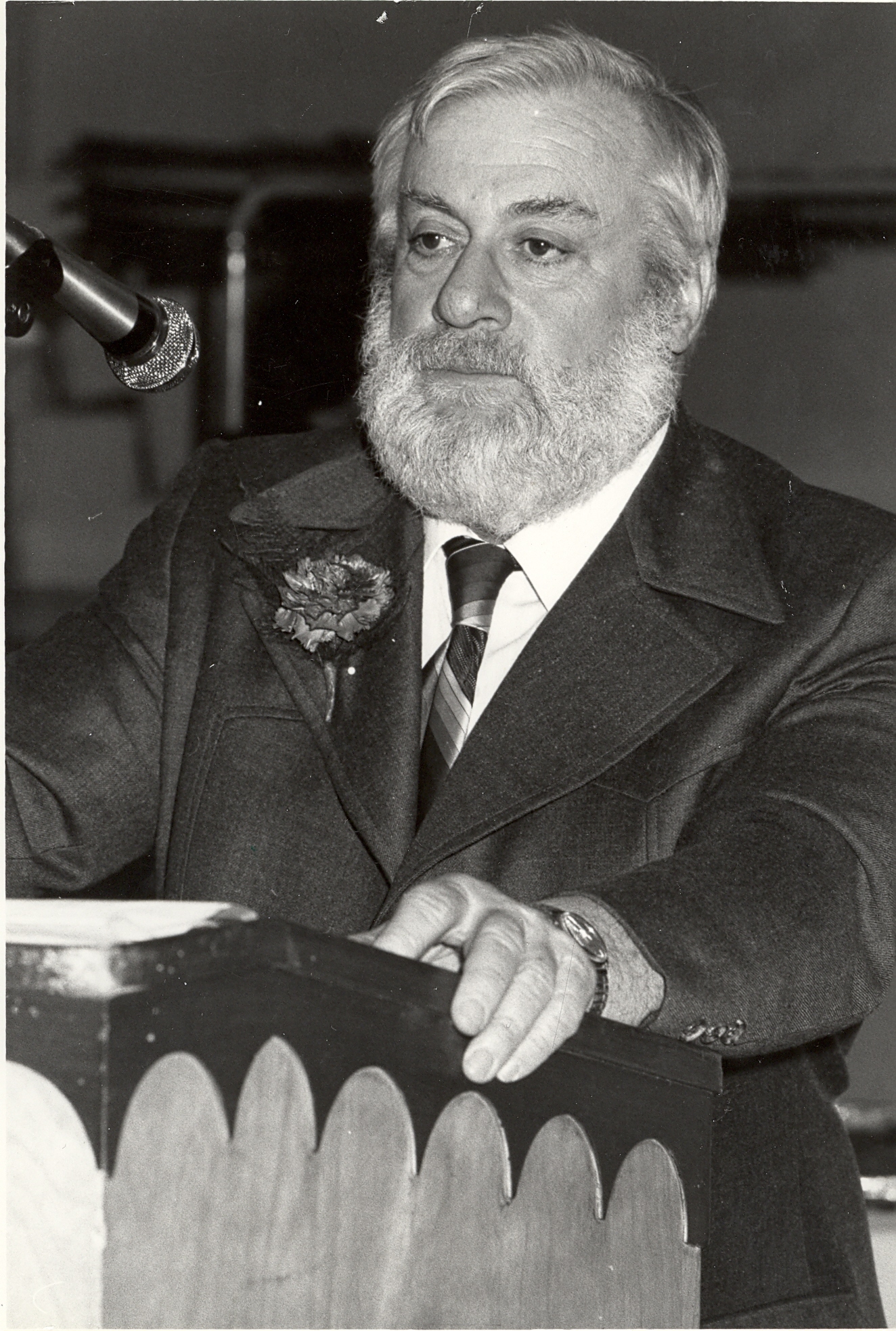
Eric Cooper, Financial Secretary (1964-1976)
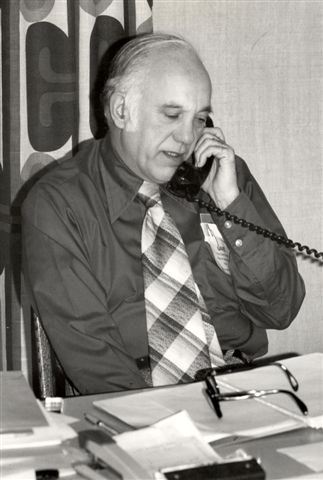
On March 1st 1976 an era for Local 199 came to an end, Eric Cooper after 22 consecutive years of unbroken service in office retired. Eric was born and educated in Saint John’s Newfoundland; he came to Ontario in 1945 while serving in the Salvation Army War Services. Eric started working at GM in 1950 and in 1954 was elected to committeeman in the Delco division. Later the same year Eric was elected as trustee of the Executive Board and remained on the executive board until he retired. Eric served two years as Vice president and in 1959 was elected to the position of Financial Secretary, Eric took to this job like a duck to water, as if this role was made for him.
In 1965 Eric became the second full time officer at the hall, the role Eric played was an important one, he had an ability to solve problems unequalled by anyone, Nick Collini said he would jump in his car and drive to Toronto at the drop of a hat to help a member win a compensation claim.
Eric was also involved with the NDP, an active delegate to the UAW Canadian Regional Convention the CLC and OFL conventions. Eric was involved with the United Way, Canadian Mental Health Association, Saint Johns Ambulance, the Community Health Centre Wayside house and the Canadian Diabetic society and in his spare time!, he volunteered with the Salvation Army.
In Eric Coopers last article in the 199 news he thanked the trade unionist that helped him learn the ropes through the early years; President John Ideson, National Rep. Bill Marshal, Gordon Lambert and his co committeeman Alex Ross. Eric also offered some good advice to the young and upcoming leaders, suggesting that they should not be in a hurry to learn everything overnight. Eric said it takes time to learn, seek advice, ask for help and warned that sometimes you have to make mistakes to learn. When this happens do not be too hard on yourself. Saving what I would consider his best advice for the membership, Eric’s parting words were to tell the membership how important it is to take an active role in politics. Labour has made some hard won gains over the years but warns us that what we have gained can be taken away at the stroke of a pen by Ottawa. These comments are very prophetic considering the challenging times Labour is currently in. The sweeping legislation changes happening in Wisconsin and the forced contract talks in 2009. Considering Eric wrote this advice 35 years ago, he must have been looking into his crystal ball back in 1976.
Romeo Lemay and Gerry Michaud joint Editors of the 199 news said that everyone in the elected leadership of the time learned from Eric Cooper with no exception. Over the years Eric Cooper became one of the mainstays of our local union, and that it would be hard to imagine the local without him. Eric had a very pleasant manner and a vast knowledge that would be missed.
Eric was not a big man in stature but it would take two to replace him, without exaggerating Eric was a giant of a man.
Len Harrison, A Flame that Still Burns Brightly (1934 -2018)
written by Jesse Aubertin & edited by Peter Scott in 2011 again in 2018
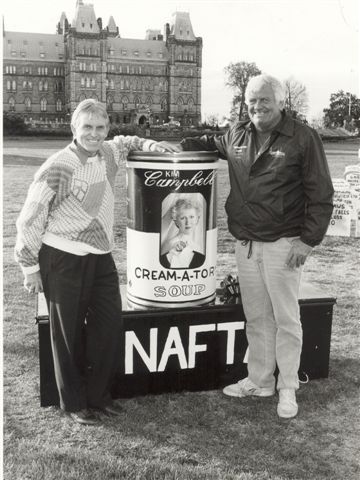
From a young age, Len Harrison, was interested in labour and politics, both of which would become a lifelong dedication. Len was born in England in 1934 and grew up in a politically involved family. Len’s father Leonard Harrison was a representative on the local town council in England. After attending a rally in his home town of Grangetown, England, at the age of eleven, Len gained an interest in the activities of the Labour Party and from this point forward his dedication to advocating for the rights of workers would have no turning back.
During his childhood, Len participated in every school play, during this time he developed a love for the arts and performing in public that to this day has never left him. The skills Len learned during these early formative years helped shape his career, honed his ability to captivate a crowd, and send a political message often in a humorous or mischievous way.
In 1955, the young Harrison family consisting of Len, his wife June and son Antony James, immigrated to Canada. Len said when they travelled from Quebec to Hamilton, I only had only five dollars in my pocket, quite a scary situation when you have a family to support. Len came to Canada with dreams of a better life for not only his family, but all the workers that surround him. Len had a burning desire in his belly to make a difference for everyone. Len said “After going down the road to find a job,” he was offered employment as a millwright at Stelco, a steel plant in Hamilton, where he would work for the next 10 years. It wasn’t long before the outspoken and opinionated Harrison became involved with the union and was elected to the position of chief steward.
On January 11, 1965 Len changed employers and he would embark on his thirty-three year career at the GM plant referred to as the “Foundry” and became a member of the UAW. This change ignited the flame that was to become Len Harrison’s political career. Len said despite the horrible working conditions in the plant, the camaraderie in the foundry was second to none, workers knew how to support each other, and they were one big family. During the early foundry days, Len saw that the workers needed better working conditions and significantly higher wages for the work they were doing. At this time, Len’s strong New Democrat ideologies surfaced and he set out to make a contribution.
After years of dedication to the foundry, Len’s political side would begin to emerge. Len wrote countless articles for the local union newspaper called “As I See It”. Len distributed union materials and articles around the plant to raise the membership’s awareness about the issues of the day. Getting your name out in the plant was very important in those days, especially if you wanted to get elected to any position. To this end, everything Len distributed in the plant had the words “Please Return to Len Harrison” written across the top. “I didn’t get to many articles back, but everyone who read it, saw and recognized my name!”
Len’s articles and willingness to talk about the issues earned him significant popularity throughout the plant. Len’s political efforts in the “Foundry” would earn him a position on the Shop Committee and through this, he would further engrave his political mark through attempts to improve Health & Safety Standards, with goals to clean up the foundry & improve working conditions.
Len’s popularity and dedication helped Len to become the Editor of Local 199’s News paper. Over the years the paper earned various literary, photography and publication design awards. As a writer with a love for politics and a goal to make the “Foundry’ a better place, Len was on a mission and had every intention of making it happen. Furthermore, Len’s political agenda would further progress as he was elected President of the St. Catharines and District Labour Council. His political accomplishments would later prove to be a strong factor in supporting his Local 199, through various political movements.
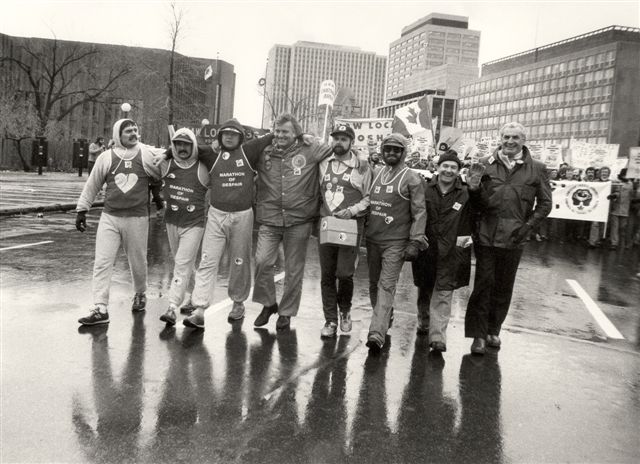
Two of the more memorable campaigns Len was involved in were the “Marathon of Despair” and the “Level Playing Field Cemetery”. Both campaigns made national television broadcasts by CBC. Len’s ability to mix political messaging with his creative and artistic side placed these issues front and center of the news. As a result, he would further increase his involvement and recognition in Local 199. Buzz Hargrove, President of the CAW at the time, told Len I always knew when you were in town, because you always created a commotion and make the news.
In 1993, during federal elections to draw attention to the conservative government’s policies Len, working with other activists promoted the Creamatory Soup campaign. CAW activist Sandy Bell designed a soup can clone called “Kim Campbell’s CREAM-A-TORY Soup” On the label it claimed the ingredients included, U.I. reductions, layoffs and plant closures, free trade, GST and was unsuitable for human consumption. 6,000 cans were made and were sold very quickly across Canada. At the time, a rumor circulated that the Prime Minister of Canada, Kim Campbell purchased a can and kept it in her office! Near the end of the campaign the CAW received a letter from a lawyer representing Campbell’s soups, demanding they stop making and selling the cans. Len in his usual quick witted manner suggested to the Lawyer representing Campbell’s, that he could quickly end the campaign if he would buy the last few hundred cans from Len! This was a classic Len Harrison move, never short on words or humour.
When it came time to retire after 33 years at GM, Len felt that he wasn’t quite ready to give up his involvement with his union. Changing gears, Len quickly adjusted to retired life and a new role within the movement.
For his political and creative abilities, and his accomplishments over the last three decades, Len Harrison was rewarded by Buzz Hargrove, and appointed to the CAW National Executive Board, Len became the first retiree to sit on the CAW NEB. Initially, Len was given voice but no vote; meaning he could talk at the board meetings but he could not vote on any of the decisions being made. Many retirees were insulted and felt this was not enough, Len’s response was “be patient, we don’t want to blow this opportunity’. Len’s foresight didn’t take to bear fruit; the NEB recognized Len’s value and contribution and gave his position voice and vote.
Since retiring, Len continues to make significant political accomplishments for retired workers, helping to train six retired members of Local 199 as retiree advocates for the Medical Awareness Program. Len said that establishing the Medical Awareness Program taught by CAW retirees is his most satisfying accomplishment with the CAW. Components of the program consist on how to speak to your doctor, healthy lifestyle recommendations, and the potential health hazards of medications. Additionally, this program offers its retired members with education and awareness towards new medications that appear in the market, their benefits and potential risks.
Len received the Dan Benedict award which is given to the person that best exemplify the spirit of Dan Benedict, a lifelong supporter of working people and instrumental in establishing the Paid Education Leave (PEL) program, the largest single adult educational program for working men and women in Canada. The award was presented to Len Harrison at the Coalition’s General Assembly to recognize his embodiment of Dan Benedict’s spirit of extraordinary community activism and commitment to the protection and extension of public Medicare. Len stood shoulder to shoulder with Dan during his life and struggles – both outspoken advocates for social justice, workers’ rights and education, quality public health care, justice for seniors and tireless and creative campaigners for a better tomorrow.
Len Harrison’s colourful resume with the CAW shows he truly has a heart of gold.
In conclusion I must say that I was honoured to have the opportunity to interview Mr. Harrison and have been truly moved by the lifetime of achievement. Len’s childhood dream was to carve out a better life for his family and improve the workplace for the workers around him, a dream he has no doubt accomplished.
I personally have gained a greater knowledge of the past and its struggles and hope all that read this article will feel the same. I would like to leave you with two quotes from Len Harrison that guided his life and helped him make a difference for his family and countless union members.
Len told us “When I talk with my family, on the phone or in person, I always think, this could be the last conversation I have with them. It is very important to me, that they know how I feel about them, so I never end a conversation with a family member, without saying I love you.”
Len Harrison was the CAW Chair of Retirees Advisory Executive, a Member of the National Executive Board of the CAW and the Chair of Niagara Area Committee for Retired Workers
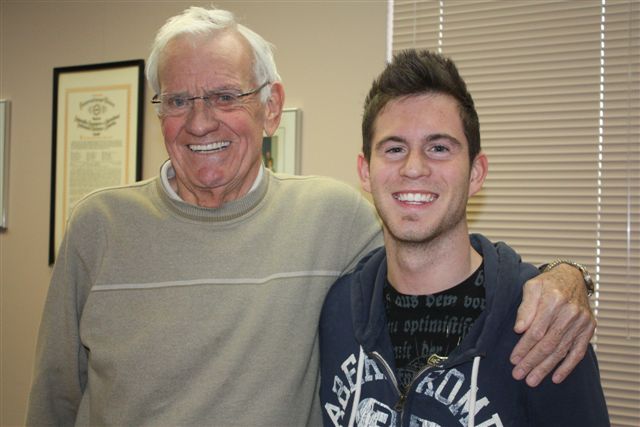
Nobody said you have to change the world, but as long as you spend your life trying, there is no better feeling than that
Len Harrison
When Len Harrison was born there was a spark, a spark that became a flame that to this day burns brightly through those who he encouraged and inspired through his creative activism. He deserves to be recognized for the life long achievements he made on behalf of the labour movement and for making this world a better place to live. Our responsibility is to ensure that we pass the torch lit by Len and so many others like him, and we continue this battle for a greater living for all. If you would like to see more pictures of Len Harrison click on the following link
Peter Scott, Unifor Local 199
Link Our Flickr Album featuring Images of Len Harrison
Ron Davis, President Local 199
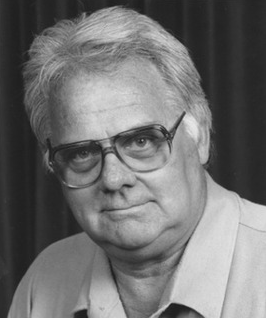
RON DAVIS By Gerry Michaud
Ron & I were first elected as foundry committeemen in 1971. Ron was the backshift committeeman and I was on afternoons. Following our first term of office Ron went on to be elected as a day shift committeeman and in those days, because the bargaining committee members elected the shop committee and the Blue Slate held a majority, he was elected to the shop to represent the molding and melt lines a position he held until Leo Rustin was appointed to staff; at which time he became acting plant chair. He was also elected as vice president of the local and served on both the GM master bargaining committee and the local committee.
I used to love to stand next to Ron when we were distributing material at the pant gates. Unlike myself he had a phenomenal memory for names. I used to piggyback on that ability of his. He would say “hi Joe” and I could then say something like “How’s it going Joe”. Ron made me look good.
Prior to the 1979 election for president, both Ron and I wanted to be candidates for the Blue Slate Caucus. When I won the nomination Ron couldn’t have been more gracious. He had told me prior to the election in the caucus that we were friends and whatever the result we would remain friends after. He was true to his word and I never had to worry about my back. In that election Ron was re-elected as vice president and continued to serve the local as a GM shop committeeman and vice president of the local.
Around 1980 following Brother Rustin’s appointment to the UAW staff, Ron served as acting GM plant chair until an election was held. Brother John Clout defeated Ron in that by-election and also in the subsequent one for a full 3 year term. This left Ron with the Vice President’s position and because he no longer had conflicting duties with the GM unit, I was able to bring him in to the union hall on lost time to help out the full time officers who at that time were swamped.
Our membership in the GM unit was close to 9,000 members, plus we had six or seven hundred members in the other 12 or 13 units of the local. Add a large retired membership to that total and we were servicing almost 11,000 members in a variety of ways, including advocacy for Workers Compensation, Unemployment insurance benefits and co-ordinating with the various benefit reps in the GM plant. It was not unusual for there to be a line of 10 or 15 members waiting to see one of the full time officers. Most of the load fell on the Financial Secretary as the president’s duties with the GM unit and the servicing & contract negotiations of the other units of the local didn’t leave the president a lot of time to help out. It became more and more necessary to bring in another officer to help ease the load on the financial secretary and so finally we went to the membership and asked for a third full time officer.
As a result, Ron became the first full time vice president of the local. He quickly adapted and not only took a lot of the work load on himself, but also found an income tax loop hole in the disability sector that saw something in the neighbourhood of one million dollars returned to many of our members in cash rebates. After I left the local to accept the directorship of the union’s Education Centre in Port Elgin, Ron, as vice president automatically became president. In the subsequent election he unselfishly stepped aside to allow John Clout to run as the Blue Slate candidate for president. Later, John decided to run again as plant chair and Ron was elected as president, a position he held until retirement. In fact Ron holds the distinction of being the first president in the history of our local union to retire from the office of president.
I knew Ron for almost 50 years and during all that time I never knew him not to be cheerful and positive. He worked hard on behalf of membership and was an important part of the history of our local. On behalf of our membership I extend heartfelt condolences to his widow Myrna, his sons and daughter, on the loss of good man.
Gerry Michaud, Unifor Retiree and Past President Local 199
Link to More Images of Ron Davis
